
We have the biggest selection of Ficus Tuffi grades which we deliver and plant across Auckland and the North Island. Call us today on 022-4559487 for a fast free quote.
Articles About Ficus Tuffi
The Benefits of Ficus Tuffi Hedging
Ficus Tuffi, also known as Ficus Tuffy, is rapidly becoming a preferred choice for hedging in New Zealand, particularly in Auckland. With its dense, lush foliage and remarkable growth rate, this versatile plant offers numerous benefits, making it an ideal option for both residential and commercial properties. If you’re considering adding Ficus Tuffi to your landscape, here’s why it’s a decision you won’t regret.
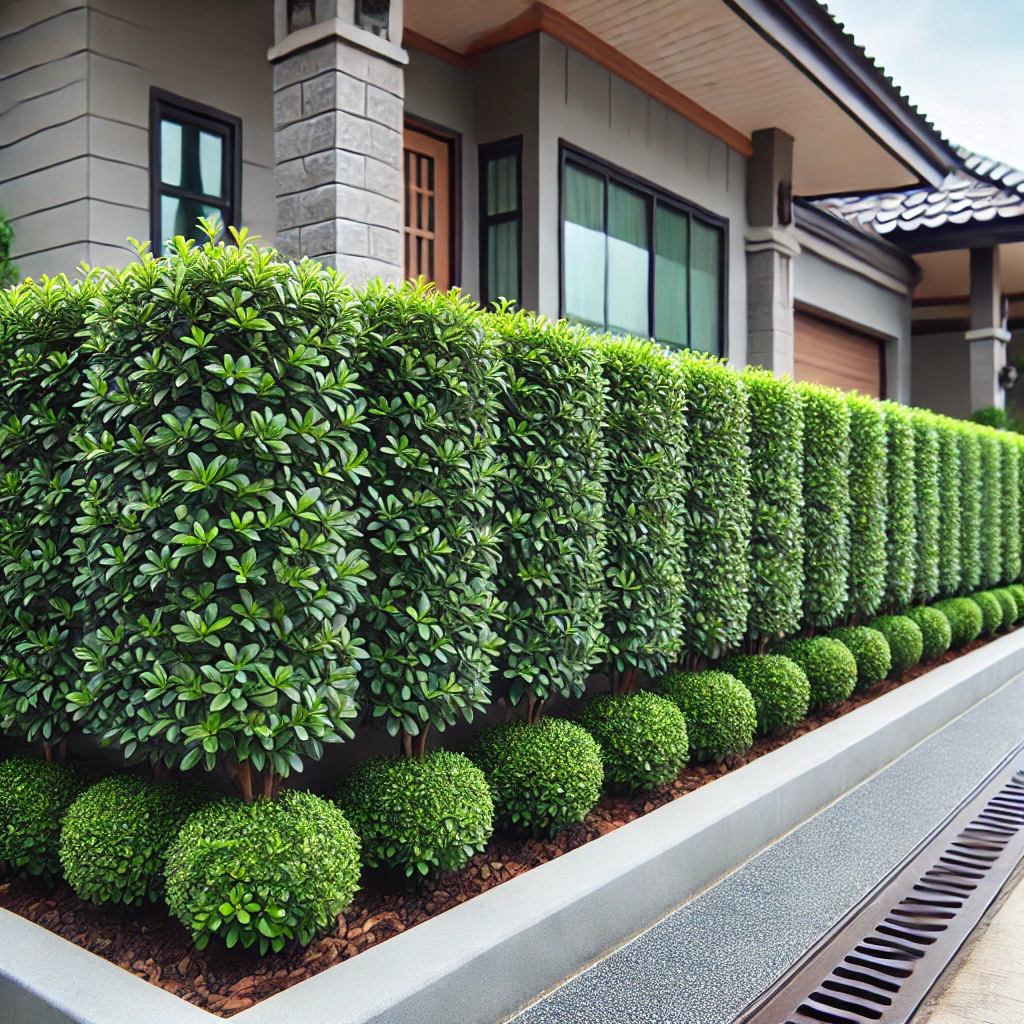
1. Exceptional Privacy and Security
One of the primary reasons homeowners and businesses opt to search for for Ficus Tuffi for sale is its ability to create an instant privacy screen. The plant’s dense, evergreen foliage grows quickly, forming a thick barrier that effectively blocks out unwanted views and provides a sense of seclusion. In urban areas like Auckland, where properties are often close together, Searching for Ficus Tuffi for sale is an excellent solution for enhancing privacy without compromising on aesthetics.
Moreover, the thick hedging can serve as a natural security measure. The dense growth of Ficus Tuffi makes it difficult for intruders to penetrate, adding an extra layer of protection to your property. This combination of privacy and security makes Ficus Tuffi a smart choice for anyone looking to create a safe, secluded environment.
2. Low Maintenance and Resilience
Ficus Tuffi is not only visually appealing but also incredibly low maintenance. Once established, it requires minimal care, making it perfect for those who want a beautiful hedge without the hassle of constant upkeep. It’s drought-tolerant and can thrive in various soil types, though it prefers well-draining soil. In the unpredictable weather conditions of Auckland, Ficus Tuffi proves to be resilient, withstanding wind, salt, and even light frost.
Regular trimming is necessary to maintain its shape and density, but even this task is relatively simple. The plant responds well to pruning, encouraging denser growth, which further enhances its role as an effective privacy screen. With Ficus Tuffi, you can enjoy a lush, green hedge year-round without dedicating excessive time and effort to its maintenance.
3. Versatility in Design
Whether you have a modern, minimalist landscape or a more traditional garden, Ficus Tuffi fits in perfectly. Its versatility in design is one of its standout features. The plant can be shaped into formal hedges or allowed to grow more naturally for a relaxed, informal look. It can also be used in topiary, providing endless possibilities for creative landscaping.
Ficus Tuffi’s adaptability extends beyond its aesthetic appeal. It can be grown as a standalone hedge, a windbreak, or even as a backdrop for other garden elements. This adaptability makes it a valuable addition to any landscape design, offering both functional and decorative benefits.
4. Eco-Friendly and Sustainable
In today’s world, where sustainability is increasingly important, Ficus Tuffi stands out as an eco-friendly choice. The plant contributes to a healthier environment by filtering air pollutants and providing a habitat for local wildlife. It also plays a role in reducing noise pollution, particularly in busy urban areas like Auckland. The dense foliage acts as a sound barrier, absorbing noise from traffic and other sources, creating a more peaceful environment.
Additionally, Ficus Tuffi is a long-lasting investment. With proper care, these hedges can thrive for decades, offering continuous benefits without the need for frequent replacement. This longevity, combined with its low water requirements, makes Ficus Tuffi a sustainable choice for eco-conscious gardeners and landscapers.
5. Enhancing Property Value
Searching for and investing in Ficus Tuffi for sale Auckland is not only about improving the look and feel of your property; it can also significantly increase its value. A well-maintained Ficus Tuffi hedge enhances curb appeal, making a strong first impression on potential buyers or tenants. The added privacy, security, and aesthetic appeal are attractive features that can boost your property’s marketability.
In areas like Auckland, where real estate is highly competitive, having a beautiful, established Ficus Tuffi hedge can set your property apart. It’s a feature that adds both monetary and aesthetic value, making it a wise investment for homeowners and property developers alike.
6. Availability and Support
For those looking to purchase Ficus Tuffi in New Zealand, especially in Auckland, finding high-quality plants is easy. Reputable nurseries and suppliers offer Ficus Tuffi for sale, ensuring you receive healthy, well-established plants ready for planting. These suppliers often provide additional support, including planting services and aftercare advice, helping you achieve the best results with your Ficus Tuffi hedge.
In conclusion, Ficus Tuffi hedging offers a myriad of benefits, from privacy and security to low maintenance and environmental sustainability. Its versatility in design, coupled with its ability to enhance property value, makes it a top choice for anyone looking to create a lush, green sanctuary in their outdoor space. Whether you’re in Auckland or elsewhere in New Zealand, investing in Ficus Tuffi is a decision that will pay off for years to come.
Looking for Ficus Tuffi for sale in Auckland? Contact us today to explore the best options for your property.
Common Problems with Ficus Tuffi Hedging
Part 1 Of Our 2 Part Series
Ficus Tuffi hedging is a popular choice for creating lush, green boundaries around properties, particularly in New Zealand. However, like any plant, it can encounter several common problems, especially as it grows into a large hedge.
Being aware of these issues and knowing how to address them can save you time, money, and effort in maintaining a healthy, vibrant hedge. This article will explore some of the most common problems associated with large Ficus Tuffi hedges and provide solutions to help you keep your hedge in top condition.
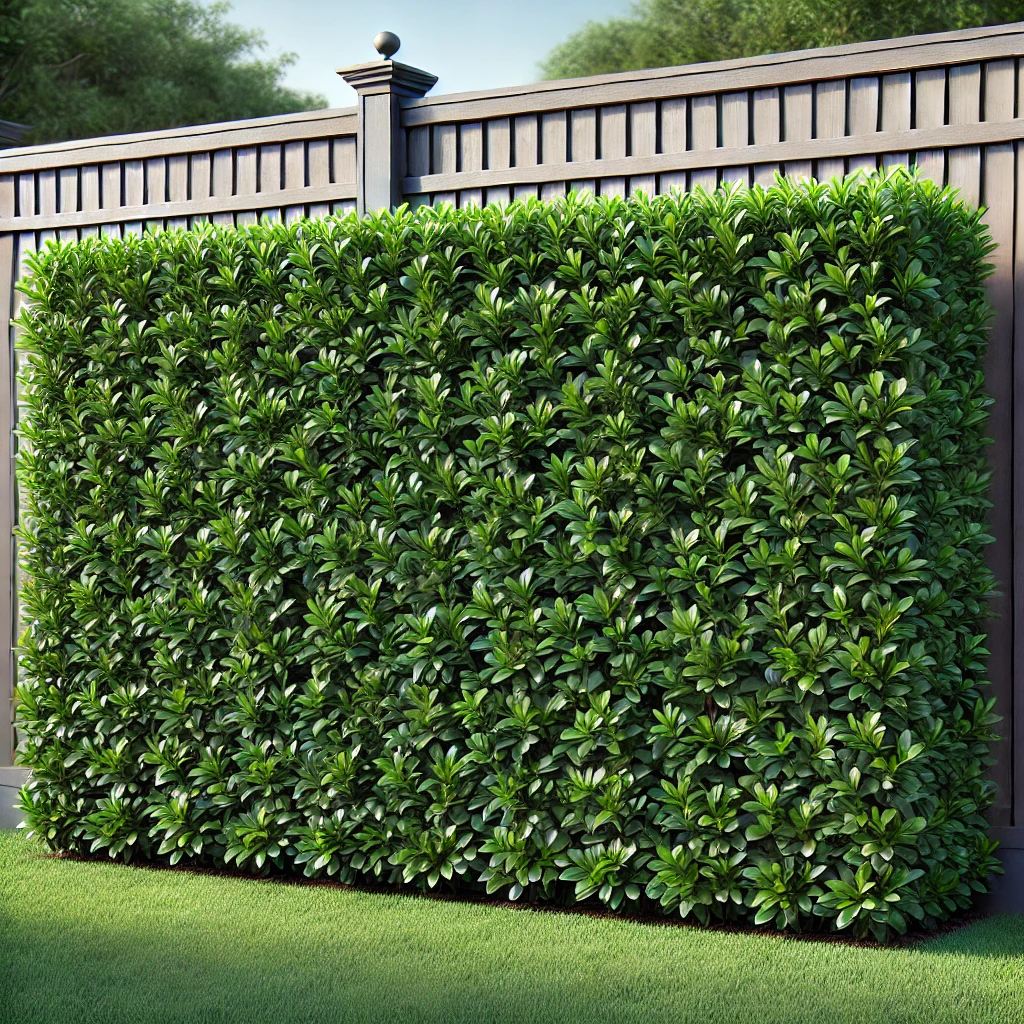
1. Root Rot
Root rot is one of the most common issues affecting Ficus Tuffi hedges, particularly in areas with poor drainage. This fungal disease occurs when the roots are constantly wet, leading to decay. Symptoms include yellowing leaves, wilting, and eventually, the death of the plant if left untreated. NZ can have very wet winter months so its pretty common.
Solution: Improve drainage around the hedge by ensuring the soil is well-draining and not waterlogged. You can achieve this by adding organic matter, such as compost, to the soil to enhance its structure. If the problem persists, consider installing a drainage system to direct excess water away from the roots. When planting new Ficus Tuffi nz hedges, ensure the soil is loose and well-drained to prevent root rot from occurring.
2. Pest Infestation
Ficus Tuffi hedges can be vulnerable to a variety of pests, including aphids, scale insects, and spider mites. These pests can cause significant damage by sucking the sap from the leaves, leading to yellowing, stunted growth, and even leaf drop. If you live in Auckland or Northland you will also notice ants collecting the white aphids eggs.
They safely hide them in hard-to-find places to hatch. The ants are addicted to the taste of the milky substances the Aphids leave as a trail.
Solution: Regular inspection of the hedge is crucial to detect early signs of pest infestation. If pests are detected, you can use organic insecticides like neem oil or horticultural soaps to control the population.
In severe cases, it may be necessary to use a chemical insecticide, but always follow the manufacturer’s instructions to avoid harming the plant or the environment. Additionally, introducing beneficial insects, such as ladybugs, can help control pest populations naturally.
3. Nutrient Deficiency
Ficus Tuffi hedges require a balanced supply of nutrients to thrive. A common problem is nutrient deficiency, which manifests as yellowing leaves, poor growth, and reduced foliage density. This issue is often caused by poor soil conditions or improper fertilization practices.
Solution: Conduct a soil test to determine the specific nutrient deficiencies affecting your hedge. Based on the results, apply a balanced fertilizer containing essential nutrients like nitrogen, phosphorus, and potassium.
It’s important to follow a regular fertilization schedule, especially during the growing season, to ensure the hedge receives adequate nutrients. Additionally, consider mulching around the base of the hedge to retain moisture and improve soil fertility.
4. Overgrown Branches
Large Ficus Tuffi hedges can become overgrown if not regularly pruned. This can lead to a tangled, unsightly appearance and can also weaken the structure of the hedge, making it more susceptible to damage from wind or heavy rain.
Solution: Regular pruning is essential to maintain the shape and health of your Ficus Tuffi hedge. The best time to prune is during the late winter or early spring when the plant is dormant. Use sharp, clean pruning shears to remove any dead, damaged, or overgrown branches.
Aim to create a well-balanced shape that allows sunlight and air to reach the inner branches, promoting healthy growth. It’s what you should look for when looking for ficus tuffi for sale. If the hedge is severely overgrown, it may be necessary to perform a more drastic cutback, but do so gradually to avoid shocking the plant.
5. Soil Compaction
Soil compaction is a common problem in areas with heavy foot traffic or where machinery is frequently used. Compacted soil can restrict root growth, leading to poor water and nutrient uptake, which ultimately affects the overall health of the hedge.
Solution: To alleviate soil compaction, aerate the soil around the hedge using a garden fork or mechanical aerator. This process involves creating small holes in the soil to allow air, water, and nutrients to penetrate the root zone. After aeration, apply a layer of organic mulch to help retain moisture and improve soil structure. Regularly aerating the soil, especially in high-traffic areas, will prevent compaction and promote healthy root growth.
By being proactive in identifying and addressing these common issues, you can ensure that your large Ficus Tuffi hedge remains a beautiful and functional addition to your landscape. For the best selection of Ficus Tuffi for sale in Auckland in grades from 1 meter tall to 2.5 meters tall. So just give us a call on 022 4559487
Remedies and Procedures for Maintaining Large Ficus Tuffi Hedges
Part 2
Maintaining a large Ficus Tuffi hedge requires consistent care and attention to prevent common problems from arising. In this section, we will outline the remedies and provide step-by-step procedures to address the issues discussed in Part 1. By following these guidelines, you can keep your Ficus Tuffi hedge healthy, vibrant, and problem-free. If you are still looking for ficus tuffi for sale then this will serve as a guide once you have them.
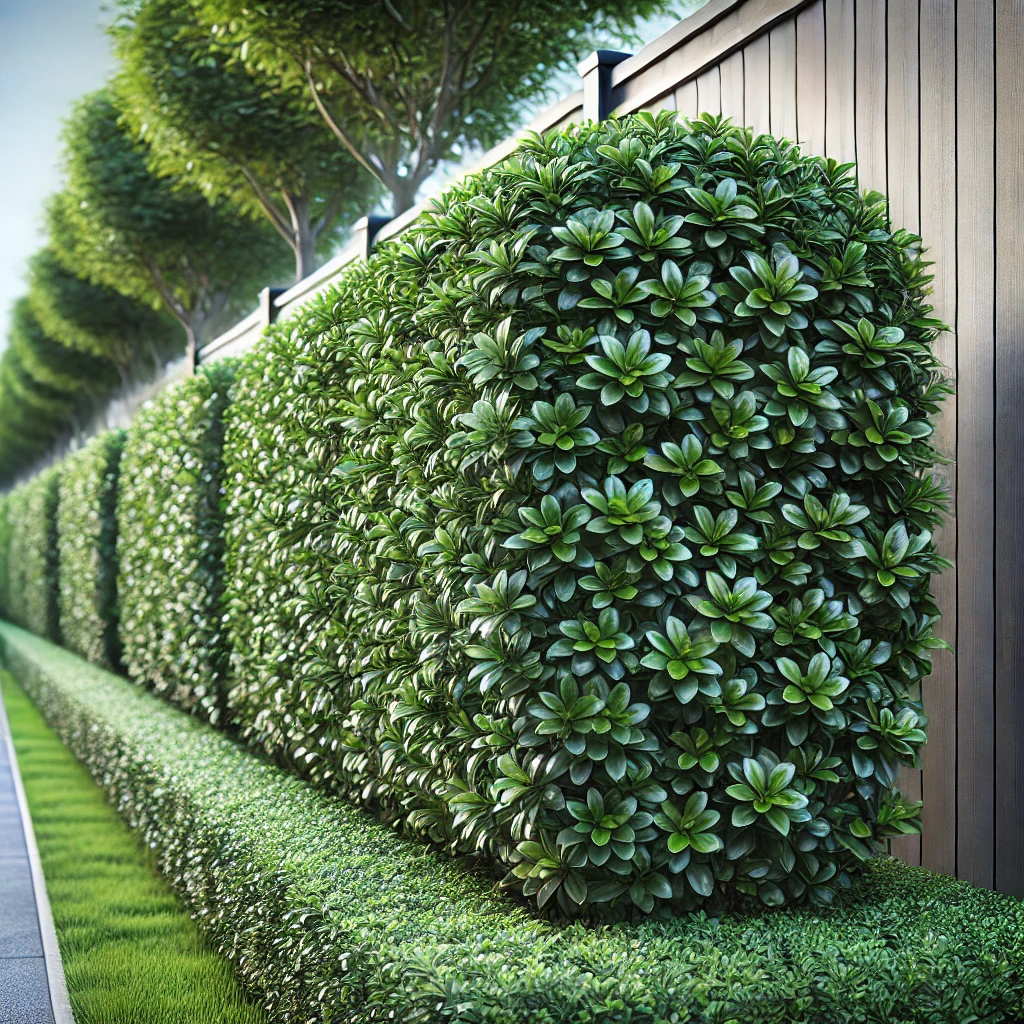
1. Improving Soil Drainage to Prevent Root Rot
Root rot can be a serious issue, but improving soil drainage is a straightforward solution.
Procedure:
Step 1: Evaluate the soil drainage by digging a small hole near the hedge and filling it with water. If the water takes more than an hour to drain, the soil is likely poorly drained.
Step 2: Amend the soil by mixing in organic matter, such as compost or well-rotted manure, to improve its structure. Work the organic matter into the top 12 inches of soil around the hedge.
Step 3: If poor drainage persists, consider installing a French drain or a similar drainage system to redirect excess water away from the hedge’s root zone.
Step 4: Mulch around the base of the hedge with organic material to retain moisture while preventing waterlogging.
2. Managing Pest Infestation
Controlling pests is crucial for the health of your Ficus Tuffi hedge and if you are still on the best ficus tuffi nz has to offer you may want to ensure the plants you are buying are pest free to start with. Check under the leaves before purchasing to see any signs of bugs.
Procedure:
Step 1: Regularly inspect your hedge for signs of pests, such as discoloured leaves or visible insects.
Step 2: If pests are detected, mix neem oil or insecticidal soap according to the product instructions and spray it on the affected areas. Apple cider vinegar works well too.
Step 3: For severe infestations, apply a chemical insecticide, ensuring you follow the manufacturer’s guidelines to avoid harming the plant or beneficial insects.
Step 4: Introduce beneficial insects like ladybugs, which prey on common pests such as aphids.
3. Addressing Nutrient Deficiency
Proper fertilization is key to preventing nutrient deficiencies in your Ficus Tuffi hedge.
Procedure:
Step 1: Conduct a soil test to identify any nutrient deficiencies.
Step 2: Based on the soil test results, select a balanced fertilizer that meets the specific needs of your hedge.
Step 3: Apply the fertilizer evenly around the base of the hedge, following the recommended application rate on the fertilizer package.
Step 4: Water the hedge thoroughly after fertilization to help the nutrients reach the roots.
Step 5: Repeat this process during the growing season to maintain nutrient levels and support healthy growth.
4. Pruning Overgrown Branches
Pruning is essential to maintain the structure and aesthetics of a large Ficus Tuffi hedge.
Procedure:
Step 1: Gather the necessary tools, including sharp pruning shears and gloves.
Step 2: Begin pruning in late winter or early spring, when the plant is dormant. Remove any dead or damaged branches first.
Step 3: Trim overgrown branches to maintain a balanced shape, ensuring that sunlight can reach the inner parts of the hedge.
Step 4: For severely overgrown hedges, prune back the hedge gradually over two or three seasons to avoid shocking the plant.
Step 5: After pruning, apply a balanced fertilizer to support new growth.
5. Aerating Compacted Soil
Aerating the soil is crucial to prevent compaction and promote healthy root growth.
Procedure:
Step 1: Use a garden fork or mechanical aerator to create small holes in the soil around the hedge, spacing the holes about 6 inches apart.
Step 2: If using a garden fork, push the tines into the soil and gently rock it back and forth to loosen the soil.
Step 3: After aeration, apply a layer of organic mulch around the base of the hedge to improve soil structure and retain moisture.
Step 4: Repeat the aeration process once a year, particularly in areas with heavy foot traffic or compacted soil.
By following these remedies and procedures, you can effectively manage and prevent common problems associated with large Ficus Tuffi hedges. Regular maintenance and attention to detail will ensure that your hedge remains a stunning and healthy feature in your landscape for years to come.
if you need any support regarding an existing hedge please don’t hesitate to call us or email us as we are always too happy to help. If you are in Auckland and you are looking for the best grades of large ficus tuffi auckland has to offer then contact us today for a fast free quote. This includes all of the north island such as hamilton and all of the waikato, Tauranga, Rotorua and as far as wellington in the south to Whangarei and the far North.
The Most 6 Most Well Known Ficus Tuffi Hedges In New Zealand
Ficus Tuffi hedges are not only practical for privacy and wind protection, but they’ve also become iconic landscaping features throughout New Zealand. These robust, evergreen plants have been used to create some of the most well-known and admired hedges in the country.
With their dense foliage and fast-growing nature, Ficus Tuffi hedges have earned their place in the hearts of both homeowners and professional landscapers. Let’s take a closer look at the six most renowned Ficus Tuffi hedges in New Zealand, where they are located, who was responsible for building them, and the fascinating stories behind their creation.

The first notable Ficus Tuffi hedge is found on the outskirts of Hamilton, at a property owned by the long-established Mathews family. This grand hedge stretches nearly 200 meters along the perimeter of their sprawling estate. Planted in the early 1990s, the hedge was the brainchild of Richard Mathews, who wanted to create a natural barrier between the estate and the nearby road while also adding a touch of elegance to the property.
Richard chose Ficus Tuffi for its fast growth and dense foliage, which would provide both privacy and soundproofing from the busy road. Over the years, the hedge has grown into an impressive wall of green, meticulously maintained by the family’s gardeners. The Mathews Ficus Tuffi hedge has since become a local landmark, admired by neighbours and passersby alike.
Next, we travel to Auckland, where one of the most famous Ficus Tuffi hedges can be found at the entrance of the prestigious Carrington Estate. This hedge was planted in the late 1990s when the estate was undergoing extensive renovations. The estate’s landscape architect, Mark Jenkinson, selected Ficus Tuffi for its ability to quickly grow into a lush, evergreen hedge that would create a grand entrance to the property.
The hedge, which spans over 150 meters, lines the driveway leading up to the main house and has become one of the defining features of the estate. Visitors often comment on the hedge’s pristine appearance, which is the result of regular trimming and expert care. Jenkinson’s vision for the entrance hedge has been so successful that other property owners in the area have since replicated the look on their own estates.
In Wellington, the grounds of the historic Fairleigh House boast another one of New Zealand’s most famous Ficus Tuffi hedges. The hedge was planted in the early 2000s when the house was undergoing a major restoration led by heritage architect Sarah Doyle. Sarah wanted to maintain the property’s old-world charm while incorporating modern landscaping elements.
She chose Ficus Tuffi for its ability to create a clean, formal hedge that complemented the grandeur of the historic home. The hedge now stretches over 100 meters around the garden’s perimeter, providing both privacy and a beautiful backdrop for the flowering plants and shrubs that grow within the garden. It has become a favorite spot for photography, with visitors often marvelling at the contrast between the modern hedge and the historic house.
Moving down to Christchurch, we find the impressive Ficus Tuffi hedge surrounding the famous Waterford Gardens. Planted in 2005, this hedge was designed by garden designer Rachel Stevenson, who was commissioned to create a hedge that would serve as both a privacy screen and a visual focal point for visitors entering the gardens. Stevenson chose Ficus Tuffi for its durability and year-round green foliage.
Over time, the hedge has become a symbol of Waterford Gardens, growing into a dense, green wall that runs along the main pathway leading into the gardens. Visitors are often struck by the beauty and symmetry of the hedge, which creates a striking contrast with the vibrant flowers and exotic plants that fill the garden’s interior. It has become one of the most photographed features in the garden, with many tourists and locals stopping to capture its beauty.
In the rural town of Te Puke, on the North Island, sits another iconic Ficus Tuffi hedge, which lines the property of a well-known kiwifruit orchard. This hedge was planted in the early 2000s by orchard owner Tony Dawson, who wanted to create a natural windbreak for his kiwifruit vines. Ficus Tuffi was chosen for its resilience and ability to withstand the strong coastal winds that frequently blow through the area.
Over the years, the hedge has grown into a towering green barrier that protects the delicate vines from the elements. In addition to its practical benefits, the hedge has become a source of pride for the orchard, with Tony often joking that the hedge is as much a part of the business as the kiwifruit itself. Visitors to the orchard often comment on the impressive size and density of the hedge, which stands as a testament to Tony’s foresight in choosing Ficus Tuffi.
Finally, no list of famous Ficus Tuffi hedges would be complete without mentioning the massive hedge that surrounds the grounds of a private residence in Queenstown. This hedge was planted in 2010 by landscape architect Fiona Black, who was tasked with designing a garden that would provide privacy and blend seamlessly with the dramatic mountain backdrop.
The hedge, which measures over 120 meters, has become a defining feature of the property. Its dense foliage provides a natural screen from the nearby road while enhancing the overall aesthetics of the garden. Fiona’s use of Ficus Tuffi in this project has earned her widespread acclaim, and the hedge has been featured in numerous gardening and design magazines.
From Hamilton to Queenstown, these six Ficus Tuffi hedges have become iconic features in their respective locations. Whether they were planted for privacy, wind protection, or simply as a beautiful landscaping element, each hedge tells its own unique story. What they all share, however, is the ability to create a stunning, evergreen backdrop that enhances the beauty of the properties they surround.
For those looking to replicate this look in their own gardens, it’s no wonder that searches for large Ficus Tuffi for sale, Ficus Tuffi for sale, and Ficus Tuffi for sale Auckland have increased in popularity. These hedges stand as a testament to the versatility and beauty of Ficus Tuffi, making them a go-to choice for gardeners and landscape architects across New Zealand.
How Does Ficus Tuffi Survive In Frosty Cold Conditions
Ficus Tuffi is known for its resilience and hardiness, which is why it’s such a popular choice for hedging across New Zealand. However, like most plants, it can struggle in frosty cold conditions. Despite being an evergreen, Ficus Tuffi is not completely immune to the damage that frost can cause, particularly frost burn.
But don’t worry, this hardy plant has some natural defences, and with a little care, you can help it thrive even in chilly temperatures.
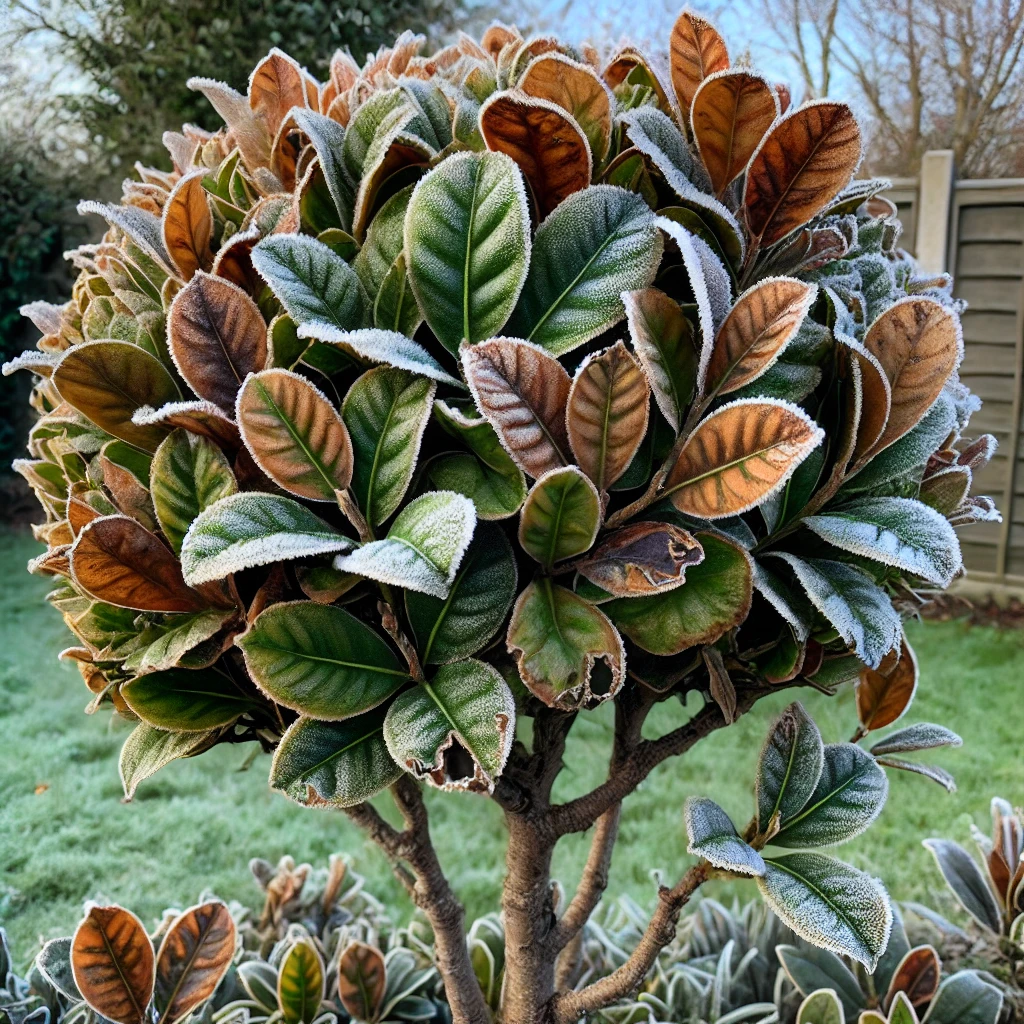
Ficus Tuffi survives cold conditions due to its ability to adapt and acclimatize. Its thick, leathery leaves help it retain moisture and resist some of the more immediate effects of frost. In addition, the dense growth habit of Ficus Tuffi provides natural insulation, with the outer layers of the plant offering some protection to the inner branches and leaves.
This natural structure allows the plant to hold up fairly well, even when exposed to colder conditions. However, if temperatures drop too low for extended periods, frost can still damage the plant by affecting the cells within the leaves.
When frost forms on the leaves of the plant, it essentially pulls moisture from them, leaving them dehydrated and burnt. This is what causes the characteristic brown patches, or frost burn, to appear. Ficus Tuffi’s thicker leaves give it some protection, but in particularly frosty regions, this might not be enough to prevent all damage.
Fortunately, there are steps you can take to prevent frost burn and keep your Ficus Tuffi looking lush and healthy throughout the winter.
One of the most effective ways to prevent frost burn is to create a physical barrier that shields your Ficus Tuffi from frost. This could be as simple as covering the plant with frost cloth during particularly cold nights. Frost cloth is a lightweight, breathable fabric designed to protect plants from frost without causing them to overheat. It allows moisture to escape while keeping the cold air off the leaves.
If you’re dealing with particularly cold winters, wrapping the hedge in frost cloth overnight and removing it during the day can make a significant difference.
Another important step in protecting Ficus Tuffi is ensuring that the plant is well-watered during the colder months. While this might seem counterintuitive, hydrated plants are better equipped to handle frost. When a plant is dry, it’s more susceptible to frost burn because the leaves lack the moisture needed to withstand the cold.
Watering your Ficus Tuffi thoroughly during the winter, especially before a frost is expected, can help protect it from damage. Just make sure the soil drains well, as waterlogged roots can cause other issues, such as root rot.
Adding mulch around the base of your Ficus Tuffi can also provide some protection from frost. Mulch acts as an insulator, helping to regulate soil temperature and protect the roots from freezing. A thick layer of organic mulch, such as bark chips or straw, will keep the ground around the plant warmer, which can, in turn, keep the plant itself from suffering frost damage.
The mulch will also help the soil retain moisture, adding an extra layer of defence against the drying effects of frost.
Pruning can also play a role in helping your Ficus Tuffi hedge survive cold conditions. By keeping the hedge well-pruned, you encourage healthy growth and reduce the likelihood of weak or damaged branches becoming susceptible to frost burn. Pruning also allows for better airflow around the plant, which helps prevent frost from settling on the leaves and causing damage.
However, avoid heavy pruning in the winter months, as this can leave the plant exposed and vulnerable to frost. Instead, focus on light pruning during the warmer months to keep the hedge in good shape.
If you’ve been searching for large Ficus Tuffi for sale or Ficus Tuffi for sale Auckland, it’s important to be aware of how to care for these plants in colder climates. While they are hardy, particularly in New Zealand’s more temperate regions, they can still suffer in particularly frosty conditions. Taking steps to protect your hedge from frost can ensure that it remains healthy and vibrant, providing the lush, green screen you want.
In particularly frosty regions, it might be worth considering the location of your hedge. Planting Ficus Tuffi for sale in a sheltered spot, such as near a wall or in an area protected from strong winds, can help reduce the impact of frost. If you’re planning to plant a new hedge, consider the microclimate of your garden. A sunnier, more sheltered location can help protect the plants from frost while ensuring they get the light and warmth they need to thrive.
Ficus Tuffi is a hardy plant, but like any living thing, it needs a little help when the weather turns cold. By providing the right care and protection, you can ensure that your hedge stays healthy and frost-free, ready to bounce back once the warmer weather returns. From watering and mulching to covering and strategic pruning, a few simple steps can make a big difference in preventing frost burn and ensuring your Ficus Tuffi hedge remains a standout feature in your garden all year round.
The Medicinal Benefits Of Ficus Tuffi
Ficus Tuffi, known for its dense, glossy green foliage and fast growth, is a popular choice for hedges and privacy screens. However, many people may not be aware that, like many plants in the Ficus family, Ficus Tuffi also offers certain medicinal benefits.
While it may not have the same extensive traditional medicinal history as its cousin, the fig tree, Ficus Tuffi still carries properties that make it valuable in holistic and natural wellness practices. Let’s explore the ways this plant can contribute to health, well-being, and even some surprising medicinal uses.

One of the primary benefits of Ficus Tuffi lies in its natural ability to purify the air. While not a traditional medicinal benefit in the sense of herbal remedies, the air-purifying quality of Ficus Tuffi can contribute to an overall healthier environment. The plant absorbs toxins from the air, including formaldehyde and other volatile organic compounds, helping to improve indoor air quality.
A cleaner environment, free from pollutants, can support better respiratory health and contribute to a more balanced, healthier lifestyle. This makes Ficus Tuffi a great addition to homes and offices, especially for people who are sensitive to poor air quality or those suffering from respiratory issues.
In terms of direct medicinal uses, Ficus Tuffi can also have anti-inflammatory and antioxidant properties. While it has not been as widely studied as other Ficus species, some anecdotal evidence suggests that Ficus plants, in general, may offer mild anti-inflammatory benefits.
These benefits can be derived from the sap or leaves, which may be used in poultices or applied topically to reduce inflammation or minor skin irritations. Although Ficus Tuffi is primarily used for its aesthetic appeal, there is potential for it to contribute to skin health in more holistic approaches.
Another surprising benefit comes from the leaves of the Ficus Tuffi. Like many other plants in the Ficus family, the leaves may possess some mild antibacterial properties. In certain cultures, Ficus leaves have been used to help cleanse wounds and reduce the risk of infection.
While it’s important to note that this is not a substitute for modern medical treatments, using the leaves in a natural healing context aligns with traditional herbal practices, offering additional support to the body’s healing process.
For those dealing with stress or anxiety, simply having a Ficus Tuffi in your home or garden can provide therapeutic benefits. Studies have shown that spending time in green spaces or around plants can help reduce feelings of stress, lower blood pressure, and improve overall mood.
The calming presence of a Ficus Tuffi, with its dense green foliage, can create a serene environment, encouraging relaxation and mindfulness. Whether planted outdoors as a hedge or grown in pots, Ficus Tuffi can act as a visual and psychological balm for those in need of stress relief.
When searching for large Ficus Tuffy for sale, many people are drawn to the plant’s practical uses for hedging or landscaping. However, being aware of its lesser-known medicinal benefits can add another layer of appreciation for this versatile plant. Whether it’s improving the air quality of your home, offering some potential anti-inflammatory relief, or simply helping to create a calming, natural environment,
Ficus Tuffi goes beyond being just a visual centrepiece in your garden. In Auckland, the increasing popularity of Ficus Tuffi for sale speaks to its appeal not only as a fast-growing hedge but also as a valuable addition to holistic wellness environments.
While Ficus Tuffi is not a traditional medicinal herb in the strictest sense, it has a range of benefits that can enhance your health and well-being. By appreciating the air-purifying qualities, potential antibacterial properties, and stress-reducing effects of this plant, you can take a more holistic approach to your landscaping and gardening choices.
Whether you’re planting it for privacy or looking for a low maintenance way to boost your home’s atmosphere, Ficus Tuffi can contribute in more ways than one.
Ficus Tuffi Hedges That Have Appeared In Hollywood Blockbusters
Ficus Tuffi hedges, known for their dense, glossy foliage and fast-growing nature, have become popular in gardens worldwide. However, their appeal doesn’t stop at home landscaping. These versatile plants have made their way onto the silver screen, playing subtle but important roles in some of Hollywood’s biggest blockbusters.
Whether they were used to frame a dramatic entrance, provide a lush background for an action scene, or simply add an extra layer of green to the set design, Ficus Tuffi hedges have had their moment in the spotlight. Here are six famous films where these iconic hedges have appeared, helping to create stunning settings that leave a lasting impression on moviegoers.

One of the most well-known Ficus Tuffi hedge appearances was in the 2015 blockbuster “Jurassic World.” As the camera panned across the luxury resort, creating a serene and opulent setting just before the chaos of the dinosaur escape, Ficus Tuffi hedges lined the pathways of the high-end vacation spot.
Their neat, green structure provided the perfect contrast to the untamed wilderness of the surrounding jungle, helping to visually separate the controlled human environment from the wild and unpredictable nature of the island. The use of Ficus Tuffi hedges in this film was subtle, but they played a crucial role in establishing the calm before the storm.
Another notable appearance of Ficus Tuffi hedges can be found in the 2018 superhero film “Black Panther.” In several scenes set in Wakanda, the filmmakers utilized Ficus Tuffi hedges to frame the royal palace gardens and ceremonial spaces.
The hedges’ perfectly manicured appearance helped to convey a sense of order and tradition, while the rich, green foliage symbolized life and prosperity within the advanced African nation. The choice of Ficus Tuffi hedges in these scenes was intentional, adding a layer of visual harmony to the futuristic yet deeply rooted in tradition atmosphere of Wakanda.
The 2010 film “Inception” also featured Ficus Tuffi hedges in one of its key dreamscape sequences. As Cobb, played by Leonardo DiCaprio, navigated through a meticulously designed dream world, Ficus Tuffi hedges lined the streets, adding to the surreal yet controlled environment.
Their uniformity and dense structure contributed to the dream-like quality of the scene, where reality and imagination blurred. The visual symmetry of the hedges reflected the theme of the film, in which the mind is both structured and chaotic. Ficus Tuffi hedges, in this instance, provided the perfect metaphor for the world of dreams.
“Ocean’s Eleven” is another blockbuster where Ficus Tuffi hedges made an appearance. During the planning stages of the elaborate casino heist, Danny Ocean, played by George Clooney, and his team conducted meetings in various upscale locations, including luxurious private gardens framed by Ficus Tuffi hedges. These hedges, with their clean lines and precise trimming, underscored the slick and calculated nature of the heist. The visual sharpness of the Ficus Tuffi hedges mirrored the precision of Ocean’s well-laid plans, creating a seamless blend of set design and narrative.
In the 2006 thriller “The Da Vinci Code,” Ficus Tuffi hedges added to the mystery and tension in several outdoor scenes. As Robert Langdon, played by Tom Hanks, unravelled clues and codes across Europe, the filmmakers often used the hedges to create an atmosphere of secrecy and intrigue.
The Ficus Tuffi hedges, with their dense, evergreen foliage, created natural barriers and hidden spaces within the gardens of various European estates featured in the film. These hedges were used to symbolize the many layers of the mystery Langdon was working to uncover, as well as the hidden knowledge he was seeking.
The 2009 sci-fi film “Avatar” may seem like an unexpected place for a Ficus Tuffi hedge to make an appearance, but during one of the early scenes set in the human base, neatly trimmed hedges could be seen lining the perimeter of the military compound.
These hedges provided a visual contrast to the lush, alien environment of Pandora, highlighting the difference between the human world and the natural beauty of the planet. While the focus of the film was on the fantastical elements of Pandora, the Ficus Tuffi hedges grounded the scenes set in the human camp, providing a sense of order and control in a hostile world.
From providing a backdrop for action sequences to representing order and mystery, Ficus Tuffi hedges have become a quiet but reliable star in some of Hollywood’s biggest films. Whether you’re a gardener looking for large ficus tuffi for sale or a movie buff noticing the subtle contributions these plants make to set design, the versatility and beauty of Ficus Tuffi hedges cannot be understated.
These dense, structured plants bring a sense of calm, precision, and elegance to any setting, both on and off the screen. For those searching for ficus tuffi for sale or ficus tuffi for sale Auckland, it’s clear that these plants offer more than just functional landscaping—they bring a cinematic flair to any garden.
Does Ficus Tuffi Have A Future In Commercial Landscaping In The Years To Come
Ficus Tuffi has long been a favourite in residential gardens and hedging projects, but the question now arises: does this versatile plant have a future in commercial landscaping? As cities and public spaces continue to evolve, landscaping trends are shifting toward sustainable, low-maintenance, and aesthetically pleasing plants that can thrive in urban environments. Ficus Tuffi, with its dense, glossy foliage and fast-growing nature, could be just the plant to meet these changing demands.

Ficus Tuffi is already well-known for its role in providing privacy and sound barriers in suburban settings. Its thick, evergreen growth makes it an ideal choice for creating structured hedges and green walls. As commercial spaces increasingly value greenery for both practical and aesthetic purposes,
Ficus Tuffi is likely to find its place in urban developments, office parks, and public spaces. Its ability to grow quickly and adapt to different climates makes it a strong contender for large-scale landscaping projects.
One of the major trends in commercial landscaping is the need for sustainability. With a growing focus on eco-friendly design, architects and landscapers are searching for plants that require minimal water and maintenance. Ficus Tuffi is drought-tolerant once established, which aligns well with these goals. Its low water needs make it suitable for areas where water conservation is a priority.
This characteristic will likely boost its appeal to developers looking to reduce environmental impact while maintaining visually attractive landscapes. The plant’s ability to thrive in different soil types also makes it adaptable to the varied conditions often found in commercial developments.
Urban planners and architects are becoming more focused on using green walls and hedges to create natural barriers and improve air quality. In bustling city environments, noise pollution and air quality are two pressing concerns. Ficus Tuffi offers a solution to both. Its dense foliage can help reduce noise levels, acting as a buffer between busy streets and quieter spaces such as office courtyards and public gardens. Additionally, like many other plants, Ficus Tuffi helps filter pollutants from the air, making it a valuable addition to urban landscapes. The plant’s role in improving the urban environment could see it being used more extensively in city planning and development in the years to come.
Commercial landscapes of the future are also likely to incorporate more vertical planting. With space at a premium, the concept of “greening the grey” has gained traction. Ficus Tuffi, known for its dense growth and ability to be easily shaped, lends itself well to vertical gardens and green walls.
Whether used to cover building facades, create natural dividers, or form part of rooftop gardens, this plant’s versatility will be a significant advantage in future commercial projects. As architects and developers continue to explore vertical landscaping options, Ficus Tuffi may become a go-to choice for its adaptability and aesthetic appeal.
The demand for aesthetically pleasing, low-maintenance landscaping in commercial spaces means that plants like Ficus Tuffi, which are both functional and attractive, are well-positioned to thrive. Its uniform growth and lush green appearance offer a visually striking option for businesses looking to enhance their exterior spaces.
Hotels, office complexes, and shopping centres could all benefit from the clean lines and structured beauty of a well-maintained Ficus Tuffi hedge. The plant’s capacity to withstand trimming and pruning also makes it ideal for creating geometric designs, further contributing to its appeal in high-traffic commercial areas.
With increasing urbanization, commercial landscaping needs to focus on creating green spaces that contribute to environmental health while providing a relaxing and attractive atmosphere for people. Ficus Tuffi ticks all the right boxes for such spaces.
Its role in providing shade, reducing heat, and offering a green sanctuary in concrete-heavy environments makes it an excellent choice for the urban landscapes of tomorrow. Developers searching for large Ficus Tuffy for sale or Ficus Tuffi for sale Auckland will find that this plant offers both practicality and beauty for large-scale projects.
Looking forward, it’s clear that Ficus Tuffi has a promising future in commercial landscaping. Its adaptability, low-maintenance requirements, and aesthetic qualities make it an ideal plant for the changing demands of urban development. As sustainability and eco-conscious design become even more crucial in future projects,
Ficus Tuffi’s ability to thrive with minimal water and care will likely secure its place as a staple in commercial green spaces. Whether used for privacy, air purification, noise reduction, or simply to create beautiful, structured hedges, Ficus Tuffi is set to play a significant role in the future of commercial landscaping.
What’s In A Name ? – The Origins Of The Name Ficus Tuffi
The story of Ficus Tuffi is a fascinating one, beginning far away from the contemporary urban landscapes where it now thrives. Native to Southeast Asia, the Ficus Tuffi is a variation of the wider Ficus genus, a family of plants that boasts over 800 species. While Ficus plants have been used in everything from religious ceremonies to culinary applications, Ficus Tuffi has earned its place as a staple of hedging and landscaping. Its dense, lush foliage and rapid growth rate have made it a popular choice for gardeners and landscapers alike, but how did this specific plant earn its name?

To understand the origins of Ficus Tuffi, it helps to first dive into the history of the Ficus genus. Ficus plants have been growing for thousands of years, mainly in tropical and subtropical regions. Historically, they’ve been prized for their durability and versatility, with some species used as shade trees, others as food sources, and still others as decorative plants.
The Ficus family is diverse, ranging from the edible fig trees to the iconic banyan trees that feature prominently in South Asian culture. Ficus Tuffi, however, stands out as a hybrid species that was specifically cultivated for its use in landscaping.
The name “Tuffi” is said to have been inspired by the plant’s tough, resilient nature. This shrub is well-suited for creating dense, evergreen hedges that can withstand both harsh conditions and frequent trimming. The word “tuff” is an informal way to say tough, which reflects the plant’s ability to thrive even in less-than-ideal conditions.
Whether it’s handling urban pollution or standing strong against coastal winds, Ficus Tuffi proves to be as tough as its name suggests. By combining the general characteristics of the Ficus genus with the plant’s hardy nature, “Ficus Tuffi” became the go-to choice for gardeners looking for a reliable, easy-to-grow hedge.
Ficus Tuffi’s rise in popularity as a landscaping plant can be traced to the late 20th century, when it became increasingly favoured for its aesthetic qualities and low maintenance needs. As cities began to expand and green spaces grew more valuable, landscapers turned to plants like Ficus Tuffi for sale that could provide beauty, privacy, and air-purifying benefits. Its compact growth pattern makes it ideal for hedging, allowing it to be shaped into clean, geometric forms that are perfect for both residential and commercial properties. The plant quickly gained a reputation for being easy to manage, as it responds well to regular pruning without losing its dense, lush foliage.
Today, Ficus Tuffi can be found in gardens and public spaces around the world, including in places as far flung as Auckland. Its ability to adapt to different climates and environments is one of the reasons it remains so popular. People searching for large Ficus Tuffy for sale or
Ficus Tuffi for sale Auckland are often drawn to the plant for its versatility and resilience. It thrives in both full sun and partial shade, making it suitable for a variety of landscapes, from urban streets to suburban gardens. Its glossy green leaves provide year-round colour, ensuring that even in the colder months, your garden stays vibrant.
One of the reasons Ficus Tuffi has such staying power in the world of landscaping is its rapid growth rate. Many homeowners and businesses opt for Ficus Tuffi because it provides quick results, forming thick hedges in a relatively short period of time. Its fast growth also makes it perfect for creating natural barriers, whether you’re looking for privacy from neighbours or protection from the wind. Fi
cus Tuffi is often chosen over other plants for its ability to form a natural fence that remains lush and healthy with minimal intervention.
While its origins may be rooted in the broader Ficus family, Ficus Tuffi has made a name for itself as a reliable and attractive landscaping solution. The combination of its hardy nature, adaptability, and aesthetic appeal has cemented its place in gardens worldwide. For those interested in adding this versatile plant to their garden, finding Ficus Tuffi for sale is as easy as visiting local nurseries or searching online for suppliers. In Auckland and beyond, it’s clear that Ficus Tuffi will continue to be a favorite for years to come.
In summary, Ficus Tuffi’s name comes from its reputation for toughness and resilience, qualities that make it an excellent choice for modern landscaping. Its ability to thrive in various climates and environments, combined with its low maintenance needs, has made it a popular option for homeowners, businesses, and city planners alike. So, the next time you’re looking to create a lush, green hedge or add some structure to your garden, consider the origins of Ficus Tuffi and why it’s become such a staple in the world of landscaping.
Ficus Tuffi Make Great Bonsai’s Too – A Ficus Tuffi Creation
Creating a bonsai from a Ficus Tuffi can be a rewarding experience, combining the beauty and resilience of this popular plant with the ancient art of bonsai. Ficus Tuffi’s adaptability, fast growth, and ability to thrive in different conditions make it an ideal candidate for bonsai. Whether you’re a seasoned bonsai enthusiast or a beginner, this guide will walk you through the steps of transforming a Ficus Tuffi into a stunning miniature tree that you can enjoy for years to come.
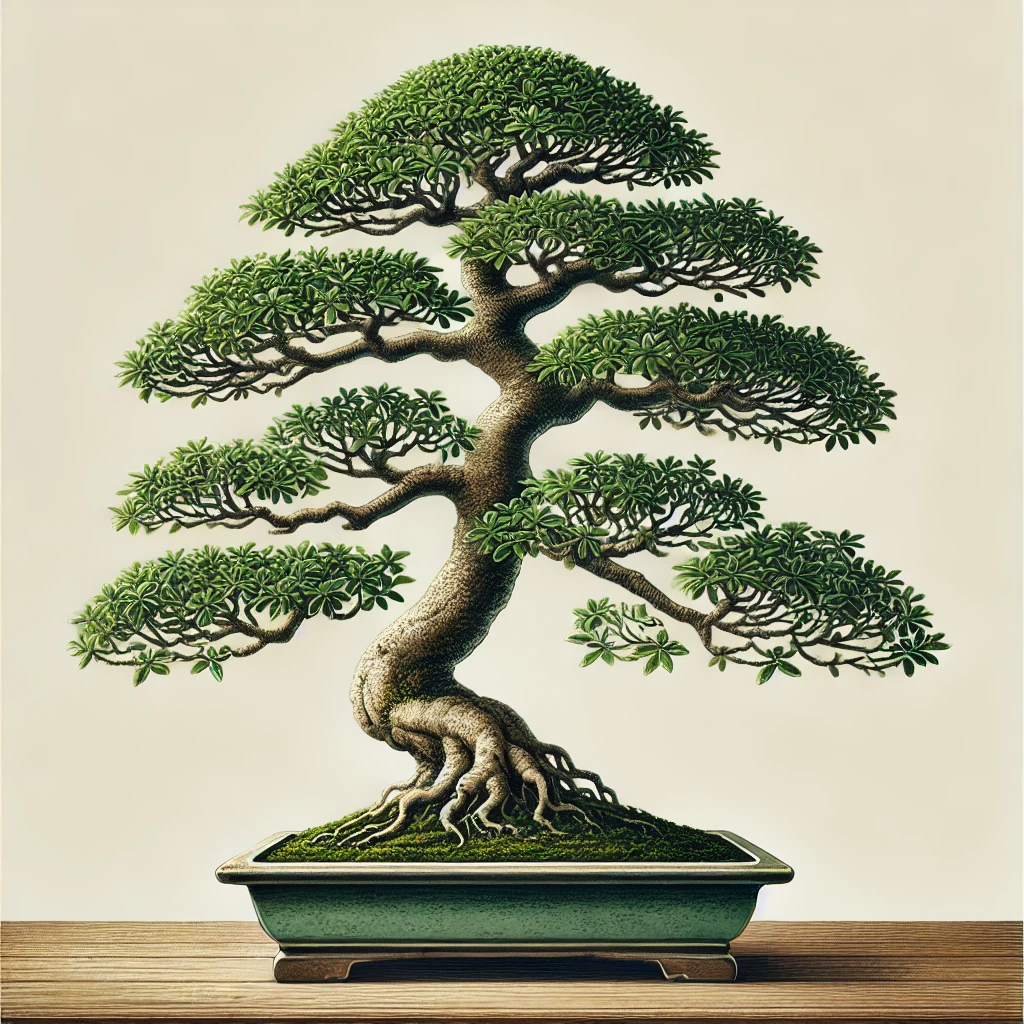
The first step in creating a bonsai from Ficus Tuffi is selecting the right plant. You want to start with a healthy, young Ficus Tuffi that has a strong, thick trunk and flexible branches. The flexibility is important because you’ll be shaping the tree as it grows, and young branches are much easier to bend and mold into the desired shape.
You can either purchase a small Ficus Tuffi specifically for bonsai purposes or, if you have a large ficus tuffy for sale nearby, start with a larger plant and trim it down. Ficus Tuffi is known for its resilience, so even a small trimming can kickstart the bonsai process.
Next, you’ll need to prepare the right pot for your Ficus Tuffi bonsai. Bonsai pots are typically shallow, which helps restrict the growth of the roots and maintain the small size of the tree. Choose a pot with good drainage to prevent water from sitting at the bottom and causing root rot.
Add a layer of small rocks or pebbles to the bottom of the pot before adding the soil. For the soil, a well-draining bonsai mix is ideal. This allows the roots to breathe while still holding enough moisture for the plant to thrive. You can also add organic matter like compost or bark to enrich the soil with nutrients.
Once you’ve selected your plant and prepared your pot, the next step is to prune the Ficus Tuffi for sale you brought. Begin by trimming away any large, unwanted branches. You want to focus on the overall shape of the bonsai and eliminate any branches that don’t fit into the design you envision. Keep in mind that bonsai trees typically have an open structure, so you’ll want to avoid creating a dense, bushy appearance.
Instead, aim for a balanced look with branches that fan out from the trunk. Don’t be afraid to trim aggressively Ficus Tuffi auckland is a fast grower, and the plant will quickly recover from a good pruning.
After the initial pruning, it’s time to wire the branches. Wiring is the process of wrapping soft, flexible wire around the branches of the tree to guide their growth in a specific direction. Start by using thin bonsai wire and gently wrap it around the branches you want to shape.
Be careful not to wrap the wire too tightly, as this could damage the bark. The goal is to bend the branches slowly over time, not to force them into position immediately. Leave the wire on for several weeks or even months, checking regularly to ensure it isn’t cutting into the bark. As the branches grow, they will adopt the shape you’ve created.
Watering your bonsai Ficus Tuffi is an important part of keeping it healthy. Ficus Tuffi auckland doesn’t like to dry out completely, so aim to keep the soil consistently moist but not soggy. The shallow bonsai pot means the soil will dry out more quickly than a traditional planter, so it’s important to check the moisture levels regularly. Use a spray bottle to mist the leaves and roots lightly, providing the plant with extra humidity.
This is particularly important if your bonsai is kept indoors, as indoor air can be dry, especially during colder months.
Finally, maintaining your Ficus Tuffi bonsai over time is crucial for its health and appearance. Prune your bonsai regularly to keep its shape and prevent overgrowth. Ficus Tuffi auckland is a vigorous grower, so don’t be surprised if you need to trim it more frequently than other bonsai species.
Repotting is also necessary every couple of years to refresh the soil and prevent the roots from becoming too cramped. When repotting, gently trim the roots to keep them compact and encourage the plant to stay small.
If you’ve ever searched for Ficus Tuffi for sale Auckland or large Ficus Tuffy for sale and found the plant’s size intimidating, bonsai might just be the answer. By following these steps, you can create a beautiful miniature version of this hardy plant. Bonsai brings together art and horticulture in a way that’s both calming and creative, and Ficus Tuffi is the perfect canvas for your next project. With patience and care, your Ficus Tuffi bonsai will become a striking, living work of art that will continue to grow and evolve over time.
Not All Pretty Plants Are Nice – The Hidden Dangers Of Ficus Tuffi
Ficus Tuffi, known for its lush green foliage and fast growth, has become a popular choice for hedges and landscaping projects. However, like many plants in the Ficus family, Ficus Tuffi has a darker side it is mildly toxic. This doesn’t mean you need to eliminate Ficus Tuffi from your landscaping plans, but it’s important to understand how its toxicity affects humans, pets, and future landscape designs.
Ficus Tuffi contains a milky sap that can cause skin irritation and allergic reactions in some people. The sap, known as latex, is common to many plants in the Ficus family. When the plant is pruned or damaged, the latex is released. For most people, contact with the sap results in mild skin irritation or rashes, but for those with sensitive skin or latex allergies, the reaction can be more severe.
Washing the skin immediately after contact usually resolves the issue. While the sap isn’t lethal, it’s best to handle Ficus Tuffi with gloves and avoid direct contact with your eyes or mouth.
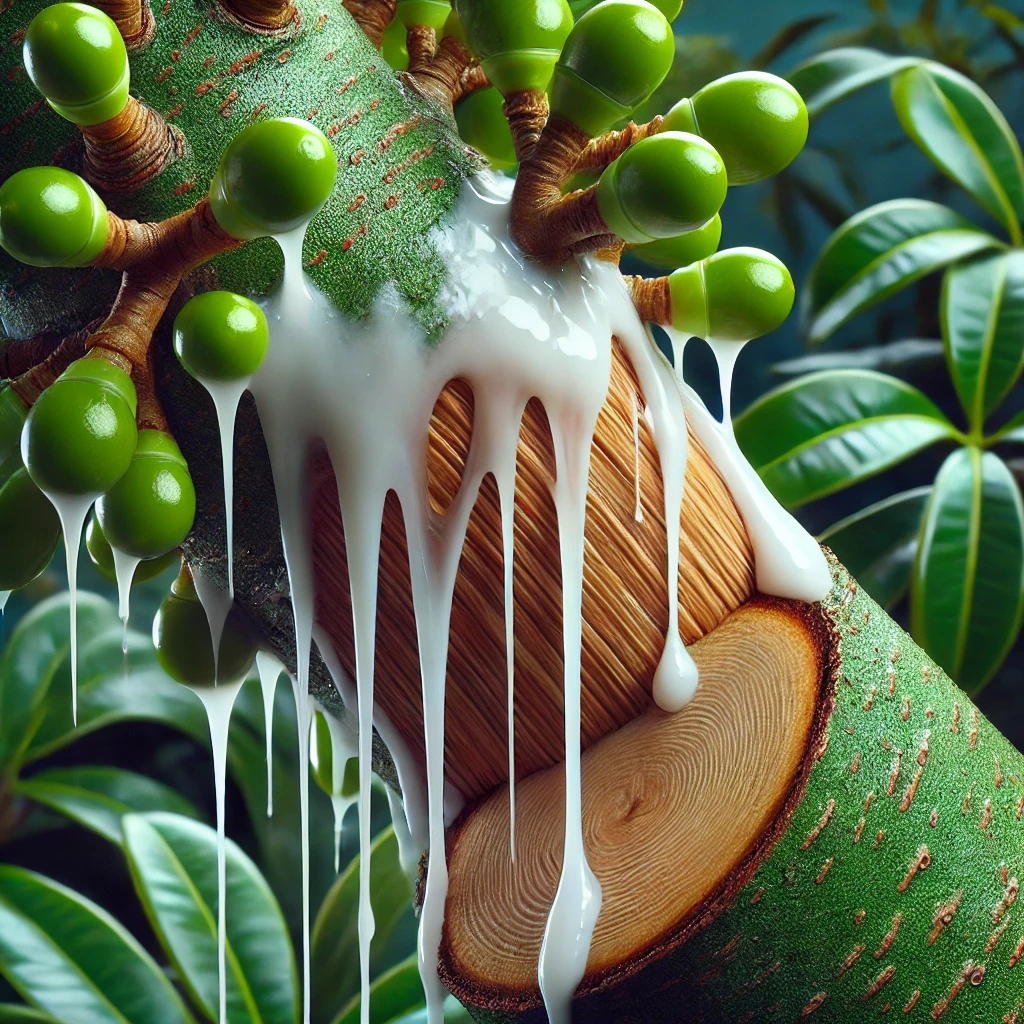
The toxicity of Ficus Tuffi also extends to pets, particularly cats and dogs. If ingested, the leaves or sap can cause gastrointestinal distress, including vomiting, drooling, and diarrhoea. While it’s unlikely that Ficus Tuffi would be deadly to a pet, it can certainly make them uncomfortable. Pets usually avoid plants that taste unpleasant, but curious animals may still nibble on the leaves.
If you have pets, it’s important to consider this when planning your garden. Keeping the plant out of reach or using barriers to prevent access can help reduce the risk of ingestion. In cases where pets ingest Ficus Tuffi, it’s best to consult a vet for advice.
Despite its toxicity, Ficus Tuffi for sale still holds a strong place in the future of landscaping. Its fast growth, resilience, and ability to thrive in different climates make it a popular choice for commercial and residential landscapes.
As urban spaces evolve, plants that provide aesthetic value, privacy, and environmental benefits are in high demand. Ficus Tuffi for sale fits these requirements perfectly, especially in areas where dense hedges or sound barriers are needed. Its ability to withstand pollution and urban stresses also makes it suitable for city landscapes.
In future landscapes, we are likely to see more green spaces integrated into urban environments. The rise of vertical gardens, rooftop gardens, and urban green walls means that plants like Ficus Tuffi auckland will continue to play a prominent role. These designs not only improve air quality but also enhance the aesthetic appeal of buildings.
Ficus Tuffi’s ability to be pruned into clean, geometric shapes makes it an ideal candidate for these modern landscapes. Its dense foliage and adaptability allow it to thrive in both traditional hedges and innovative green walls, ensuring it remains relevant in future designs.
When selecting Ficus Tuffi for future landscapes, understanding its toxicity is important. While it may not be a major health hazard, awareness allows homeowners and landscape designers to take appropriate precautions. For example, in spaces where children or pets frequently play, it may be necessary to plant Ficus Tuffi for sale in less accessible areas or use alternative plants for those sections. In public spaces, clearly labelling plants that may cause irritation could help prevent unwanted contact.
These simple steps can ensure that Ficus Tuffi remains a popular choice without compromising safety.
Ficus Tuffi’s toxicity shouldn’t overshadow its many benefits in landscaping. Its ability to create dense, green walls and natural barriers has made it a favourite among gardeners, urban planners, and homeowners. As we move toward more sustainable and eco-friendly landscapes, Ficus Tuffi will continue to fit in perfectly, provided that its toxic nature is managed properly.
In Auckland, the demand for Ficus Tuffi for sale shows no sign of slowing down, and many nurseries are offering large ficus tuffy for sale to meet the growing demand.
When planning your garden, it’s essential to consider both the advantages and potential drawbacks of Ficus Tuffi. Its fast growth and low maintenance needs make it an appealing option, especially for those looking to create privacy screens or wind barriers. However, if you have children, pets, or are concerned about skin irritation, it’s wise to take precautions.
Simple solutions such as wearing gloves while pruning, keeping pets away from the plant, and strategically placing it in less accessible areas can help mitigate the risks while allowing you to enjoy the beauty and benefits of this versatile plant.
In conclusion, while Ficus Tuffi has mild toxic properties, it remains a highly desirable plant for future landscaping projects. Its adaptability, fast growth, and ability to thrive in urban environments make it a perfect fit for modern landscapes.
By taking appropriate precautions and being aware of its toxicity, you can safely incorporate Ficus Tuffi auckland into your garden or commercial landscaping project. With growing interest in green spaces and sustainable urban design, Ficus Tuffi is sure to continue playing a key role in shaping the landscapes of tomorrow.
The Most Incredible Ficus Tuffi Hedge In The Whole World – Ficus Tuffi Gone Mad
There are many impressive hedges around the world, but none quite compare to the colossal Ficus Tuffi hedge that has earned the title of the largest and most incredible in the world. Located in the picturesque countryside of southern Italy, this massive hedge spans an astonishing 300 meters in length and stands at a towering 12 meters tall. It’s so large that you could almost mistake it for a green wall of a building, except that this one is alive and thriving.
Imagine walking alongside it and feeling like a tiny ant next to a gigantic green fortress. This Ficus Tuffi hedge is a masterpiece of landscaping and truly a wonder to behold.

The hedge was planted over 50 years ago by renowned Italian landscape architect Antonio Ferreti, who had a vision of creating the most impressive living wall the world had ever seen. He chose Ficus Tuffi for its rapid growth, dense foliage, and its ability to be shaped and maintained into neat forms. Initially, people were sceptical of Antonio’s grand plan. How could such a massive hedge be planted, grown, and maintained?
But Antonio, with his sharp horticultural mind and dedication to the project, made it happen. He began by planting hundreds of young Ficus Tuffi for sale trees along a custom-built iron frame, which served as the initial structure for the hedge. Over time, the trees grew and wove together, forming an impenetrable wall of green.
Today, this enormous Ficus Tuffi hedge is not just a natural barrier but a work of living art. Antonio’s original frame is no longer visible, as the large Ficus Tuffi has completely overtaken it. The hedge is kept in pristine condition by a dedicated team of gardeners who use lifts and scaffolding to prune it regularly.
They shape it with such precision that it looks like it’s been carved from a single block of greenery. Tourists from all over the world come to marvel at this gigantic hedge, which has become something of a local legend. People often ask, “How on earth do they keep it looking so perfect?” It’s a question that Antonio’s team answers with a simple smile and a knowing look the result of years of care and expertise.
Apart from its sheer size, one of the most fascinating aspects of the hedge is its environmental impact. The hedge acts as a natural air purifier, absorbing large amounts of carbon dioxide and releasing clean oxygen into the atmosphere. It’s estimated that this Ficus Tuffi auckland hedge can filter as much air as several acres of forest, making it not only a visual marvel but an environmental powerhouse.
Additionally, the hedge acts as a natural sound barrier, blocking out noise from the nearby road and creating a peaceful, quiet environment within the estate it borders. It’s easy to forget the outside world even exists when you’re standing in the shadow of this massive green wall.
What’s even more impressive is that the hedge isn’t just a single wall of green. Antonio’s design includes intricate mazes, tunnels, and alcoves hidden within the hedge itself. These secret pathways are a favorite among visitors who want to experience the hedge up close.
Walking through the hedge’s winding pathways feels like entering another world where nature reigns supreme. The combination of its size, design, and the interactive experience it offers makes this large Ficus Tuffi hedge a true wonder.
While Ficus Tuffi is commonly known for its use in smaller hedges and privacy screens, this hedge proves that with the right care and imagination, it can be used to create something truly monumental. In fact, seeing this hedge has inspired many visitors to try their hand at growing their own Ficus Tuffi hedges, leading to increased demand for large Ficus Tuffy for sale and Ficus Tuffi for sale. Nurseries around the world have reported a spike in interest from gardeners eager to replicate Antonio’s masterpiece, even if on a smaller scale.
And it’s no wonder Ficus Tuffi has become such a popular choice for landscaping projects. Its dense, evergreen foliage provides year-round beauty, and its rapid growth makes it an excellent option for those looking to create privacy screens or green barriers.
For those in Auckland, the search for Ficus Tuffi for sale Auckland has been particularly active, as urban gardens and landscapes incorporate this versatile plant. Whether you’re planning a modest backyard hedge or dreaming of your own grand landscaping project, Ficus Tuffi offers the flexibility to make it happen.
The maintenance of this giant Ficus Tuffi auckland hedge is no small task, but the reward is a living sculpture that stands out as one of the most remarkable landscaping achievements in the world. Antonio’s original vision was to create something that would not only stand the test of time but become a lasting testament to the beauty of nature combined with human ingenuity. It’s safe to say that he has succeeded beyond his wildest dreams.
As for the future, there are plans to expand the hedge even further, adding additional pathways and features to enhance the visitor experience. Antonio’s team continues to push the limits of what can be achieved with Ficus Tuffi auckland, and it seems that this already incredible hedge will only grow more impressive in the years to come.
In the world of landscaping, few creations can rival the sheer scale and impact of this Ficus Tuffi hedge. Whether you’re a plant enthusiast, a landscape architect, or just someone who appreciates the beauty of nature, this hedge is a sight that must be seen to be believed. It stands as a living example of what can be accomplished with vision, dedication, and a whole lot of Ficus Tuffi.
Ficus Tuffi Hedges In Film & TV The Big Star Ficus Tuffi Hedge
Ficus Tuffi, a popular hedge plant known for its glossy leaves and upright growth, has quietly made its mark in pop culture, from iconic movie sets to celebrity gardens. Though it might not steal the spotlight, Ficus Tuffi plays a vital role in creating lush, green backdrops that add elegance and tranquility to various scenes.
Whether it’s framing a luxurious mansion in a film or providing privacy for a famous star, this versatile plant has become a symbol of understated sophistication in the world of pop culture.
Ficus Tuffi in Film and Television

Ficus Tuffi hedges have appeared in numerous films and television series, often in the background of luxurious homes, stylish gardens, or high-end properties. Their clean, structured appearance makes them a go-to choice for set designers looking to evoke a sense of wealth and elegance.
The dense, vibrant green foliage of the Ficus Tuffi provides an ideal contrast against modern architecture, which is why you’ll frequently find it lining driveways or framing grand entrances in movies.
If you’ve ever admired a beautiful, lush hedge in a film and wondered how to recreate that look in your own garden, it’s worth searching for ficus tuffi for sale Auckland. You can enjoy the same stylish atmosphere found in the cinematic world right in your own backyard.
Ficus Tuffi in Celebrity Homes
Celebrities are often at the forefront of setting trends, including in the world of gardening and landscaping. Ficus Tuffi hedges have become a favourite among high-profile homeowners for their ability to provide privacy without sacrificing aesthetic appeal.
The tall, structured growth of Ficus Tuffi makes it an excellent natural barrier, allowing celebrities to shield themselves from the prying eyes of paparazzi while still enjoying a beautiful landscape.
Whether you’re seeking privacy or a touch of elegance, Ficus Tuffi can transform your outdoor space into something that mirrors the gardens of the rich and famous. By planting a large ficus tuffi for sale, you can achieve a lush, manicured look similar to those seen in celebrity homes, complete with all the benefits of enhanced privacy and style.
Ficus Tuffi in Modern Design
Beyond its role in film and celebrity culture, Ficus Tuffi has also become a staple in contemporary landscape design. From upscale hotels to trendy restaurants, this plant is often used to create chic, minimalist outdoor spaces.
Its versatility allows it to be used in various settings, from rooftop gardens to city courtyards. The tall, slender growth habit makes it ideal for creating living walls or adding structure to open spaces.
Modern designers Favor Ficus Tuffi for its ability to grow quickly and maintain its shape with minimal pruning. It adds a sleek, natural touch to any space, providing a breath of fresh air in urban environments. If you want to bring a touch of modern design into your own garden, exploring ficus tuffi for sale Auckland can help you find the right plants to suit your landscape.
Ficus Tuffi as a Social Media Sensation
In the age of Instagram and Pinterest, Ficus Tuffi has become a trending plant among garden enthusiasts and interior designers alike. With its clean lines and dense foliage, it often appears in posts highlighting chic outdoor spaces or minimalist home designs.
Influencers and homeowners alike are drawn to Ficus Tuffi’s ability to elevate even the simplest of spaces, making it a popular choice for backyard makeovers and garden transformations.
If you’re inspired by social media’s green trends, finding large ficus tuffi for sale can give you a head start on creating your own Instagram worthy garden.
Ficus Tuffi in the Spotlight
While it may not be as widely recognized as other plants in pop culture, Ficus Tuffi has carved out a niche for itself as a symbol of sophistication, privacy, and modern design. Whether it’s gracing movie sets, celebrity homes, or your own backyard, this plant brings a touch of elegance to any space.
For those seeking to recreate the sleek, stylish look of Ficus Tuffi in their own garden, there are many options for ficus tuffi for sale Auckland that can help you achieve your landscaping goals.
D.I.Y Ficus Tuffi – Lets Go !!!
Ficus Tuffi is a versatile and hardy plant that’s perfect for a variety of DIY garden projects. Whether you’re aiming to create privacy screens, living walls, or modern garden designs, this plant can help you transform your outdoor space into something stylish and functional.
With its dense, glossy foliage and rapid growth, Ficus Tuffi is ideal for homeowners who want a low maintenance, yet attractive, plant to enhance their landscape. In this guide, we’ll explore some great DIY ideas for using Ficus Tuffi in your garden and offer recommendations on how to get the most out of this popular plant.
Creating a Ficus Tuffi Privacy Screen

One of the most common DIY uses for Ficus Tuffi is as a natural privacy screen. Its tall, upright growth and dense foliage make it perfect for creating a barrier between your property and neighbouring homes. This can be especially useful if you want to block out street noise or create a secluded outdoor area for relaxing.
To create a privacy screen, plant your Ficus Tuffi plants in a row with about 50 to 70 cm of space between them. Over time, the plants will grow together to form a lush, green wall. Regular trimming will keep them neat and uniform. If you’re looking to start your DIY project, search for ficus tuffi for sale Auckland to find high-quality plants that will grow quickly and thrive in your climate.
Building a Ficus Tuffi Living Wall
For those looking for a more modern approach, consider using Ficus Tuffi to create a living wall. Living walls are vertical gardens that are not only beautiful but also help purify the air and reduce heat in urban areas. Ficus Tuffi’s dense foliage makes it a great candidate for this kind of project.
To build a Ficus Tuffi living wall, you’ll need a sturdy vertical frame and planters. Start by planting your Ficus Tuffi in individual planters and arranging them vertically along the frame. Make sure the frame is strong enough to support the weight of the plants as they grow. You can customize the layout to suit your space, whether it’s a full wall or just a small section of your garden. When sourcing your materials, don’t forget to look for ficus tuffi for sale that are healthy and ready to plant.
Ficus Tuffi as a Decorative Hedge
Ficus Tuffi is also an excellent option for creating decorative hedges. Its tidy appearance makes it perfect for lining pathways, driveways, or garden borders. You can even use it to shape specific garden areas or create natural rooms in larger landscapes. For those interested in modern garden design, Ficus Tuffi is a must have.
When planting a decorative hedge, be mindful of the space you have. The plants should be spaced closely enough to form a continuous line but not so close that they compete for nutrients. Regular pruning will help you maintain a uniform shape. If you’re interested in adding this feature to your yard, start by searching for ficus tufii plants for sale Auckland to get the best quality plants for your hedge.
Bonsai with Ficus Tuffi
Another creative way to use Ficus Tuffi is by making your own bonsai. Ficus Tuffi’s small leaves and flexible branches make it perfect for bonsai projects. To start, choose a young plant, and begin shaping its branches with wire to create your desired form. Over time, prune the roots and branches to maintain its compact size.
Bonsai requires patience, but the results can be incredibly rewarding. By learning the techniques of bonsai, you can turn a simple ficus tuffi for sale into a stunning miniature tree that adds charm to any home or garden.
Get Creative with Ficus Tuffi
Ficus Tuffi is a plant that offers endless DIY possibilities. From creating privacy screens and living walls to bonsai projects, this versatile plant can enhance any garden. Whether you’re looking for ficus tufii for sale Auckland to start your project or planning a more extensive hedge, Ficus Tuffi provides both beauty and functionality. With a little creativity and care, your garden can become a true masterpiece featuring this popular plant.
Ficus Tuffi For Spiritual & Magical Practices – Ficus Healing Purity
Ficus Tuffi, known for its sleek, glossy foliage and resilient nature, has more to offer than just being an attractive plant for hedging. In spiritual and magical practices, plants are often used for their energetic properties, and Ficus Tuffi is no exception. Its vibrant energy and ability to thrive in a variety of conditions make it an ideal plant for enhancing spiritual rituals, offering protection, and promoting growth in both the physical and metaphysical sense. Whether you’re a seasoned practitioner or simply looking to incorporate nature into your spiritual practices, Ficus Tuffi auckland can be a wonderful addition.
Ficus Tuffi for Protection and Grounding

One of the primary spiritual uses of Ficus Tuffi is for protection and grounding. The plant’s dense and upright growth symbolizes strength and resilience, making it ideal for rituals focused on protecting one’s space from negative energies. By planting Ficus Tuffi around your property, you can create a natural protective barrier that keeps out unwanted influences and promotes a sense of stability.
To harness the protective power of Ficus Tuffi in your spiritual practice, consider planting a hedge around your home or garden. When searching for ficus tufii plants for sale Auckland, choose strong, healthy specimens to ensure the best results. As you plant your Ficus Tuffi, you might want to set an intention or say a protection spell to charge the plant with positive energy.
Growth and Prosperity Rituals
Because of its fast growth and ability to adapt to different environments, Ficus Tuffi for sale is also associated with abundance and prosperity in magical practices. The plant’s ability to thrive even in challenging conditions symbolizes personal growth, making it perfect for rituals aimed at promoting success and manifesting wealth. Placing Ficus Tuffi near your workspace or meditation area can help attract positive energy and encourage the growth of new opportunities.
If you’re looking to add a touch of prosperity to your garden or spiritual space, consider purchasing ficus tuffi for sale to include in your rituals. As you care for your plant, visualize your goals growing and thriving just like the plant itself.
### Ficus Tuffi for Cleansing and Energy Renewal
Ficus Tuffi can also be used for cleansing rituals, particularly when clearing out stagnant or negative energies from a space. Its vibrant green foliage is believed to help refresh the energy of any environment, making it a great addition to homes or sacred spaces in need of a spiritual reset. You can use Ficus Tuffi in combination with other cleansing tools, such as sage or incense, to create a powerful ritual for clearing negative energy.
For those wanting to add this plant to their spiritual toolkit, start by looking for ficus tufii for sale Auckland. Once planted, you can incorporate Ficus Tuffi into your daily or weekly cleansing rituals by simply spending time near the plant or brushing its leaves to release any accumulated energy.
### Enhancing Meditation and Focus
Ficus Tuffi’s calming presence can also make it an excellent plant for enhancing meditation and focus. Its strong, steady growth mirrors the energy needed for a balanced, focused mind. Place your Ficus Tuffi in your meditation space to create a calming atmosphere or sit near the plant during meditation sessions to absorb its grounding energy. For those seeking a physical and spiritual connection to nature, incorporating ficus tuffi for saleinto your home or garden offers a simple way to enhance your meditation practice. Over time, the plant’s energy will merge with your own, helping to promote inner calm and clarity.
### Conclusion: Ficus Tuffi in Your Spiritual Practice
Ficus Tuffi is a versatile plant that can be used for protection, growth, cleansing, and focus in spiritual and magical practices. Whether you’re creating a protective hedge or incorporating it into your meditation space, the energetic properties of this plant make it an excellent addition to any spiritual practice. For those interested in getting started, there are many ficus tufii plants for sale Auckland that can help you incorporate this powerful plant into your life. With its beauty and strong energy, Ficus Tuffi is sure to enhance both your garden and your spiritual journey.
Ficus Tuffi in ethnobotanical studies – Yup You Heard That Right !!!
Ficus Tuffi, a popular hedge plant in modern landscapes, has also attracted interest in the field of ethnobotany. Ethnobotany focuses on the relationships between people and plants, studying how plants are used in different cultures for medicinal, spiritual, and practical purposes. While Ficus Tuffi is mostly recognized for its ornamental value today, ethnobotanical studies shed light on its broader applications, particularly in traditional practices.
Historical Uses of Ficus Tuffi

In some indigenous cultures, Ficus species have been used for their medicinal properties, and while Ficus Tuffi doesn’t have a long history of medicinal use like some of its relatives, its structural characteristics have still been appreciated. The dense foliage and sturdy branches made it a versatile plant for practical uses, such as weaving materials or crafting shelter from its leaves.
In modern landscaping, however, Ficus Tuffi shines more for its ornamental use and ability to create privacy. If you’re interested in incorporating this resilient plant into your garden, you can look for ficus tufii plants for sale Auckland, where it’s widely available for homeowners seeking to enhance their outdoor space.
Ficus Tuffi in Modern Ethnobotany
Modern ethnobotanical studies have shifted the focus of Ficus Tuffi towards its role in environmental benefits. The plant’s fast growth and dense structure make it a valuable resource in urban green spaces, where it can help reduce pollution and provide cooling effects in hot climates. Ficus Tuffi is commonly used in hedging, contributing to biodiversity in city gardens by offering shelter for birds and small animals.
While traditional uses may not be as prominent, Ficus Tuffi’s role in contemporary ethnobotany continues to evolve as its ecological benefits become more recognized. If you’re considering adding this plant to your garden, it’s easy to find ficus tuffi for sale to help create a green, ecologically friendly space.
Symbolic Significance of Ficus in Cultures
Ficus plants, in general, hold symbolic importance in many cultures. In some societies, they represent wisdom, longevity, and spiritual protection. Ficus Tuffi, with its upright growth and strong, resilient nature, can be seen as a symbol of strength and endurance. Incorporating this plant into your home garden could be a way to connect with these symbolic meanings while also enjoying its practical benefits.
If you’re inspired by the cultural significance of plants, adding ficus tufii plants for sale Auckland to your garden allows you to bring these deeper meanings into your own space.
Ficus Tuffi in Sustainable Landscaping
As interest in sustainable living grows, Ficus Tuffi has gained recognition for its low-maintenance needs and its role in creating environmentally friendly gardens. Ethnobotanical studies often focus on sustainable plant use, and Ficus Tuffi fits perfectly into this narrative. Its ability to thrive in various conditions, its tolerance to pruning, and its minimal water requirements make it a prime candidate for sustainable gardens.
By finding ficus tuffi for sale, you can contribute to a more eco friendly environment by planting a hedge that requires fewer resources to maintain while offering visual appeal and functional use in your landscape.
Ficus Tuffi’s Ethnobotanical Relevance
Ficus Tuffi may not have a long medicinal or ritualistic history like other Ficus species, but its use in modern landscapes and sustainable gardening practices shows that it remains a valuable plant in ethnobotanical studies. From its ecological benefits to its symbolic significance, Ficus Tuffi continues to have a role in both practical and cultural aspects. If you’re looking to incorporate this versatile plant into your garden, there are plenty of ficus tufii plants for sale Auckland to get you started on your green journey.
Does Ficus Tuffi Make A Sound Barrier Around Your Auckland Home
Does Ficus Tuffi Make a Sound Barrier Around Your Auckland Home?
Living in Auckland can be an exciting experience with its vibrant culture, bustling city life, and beautiful surroundings. However, with all that excitement comes the inevitable noise. Whether it’s the hum of traffic, the distant chatter of neighbours, or the sound of kids playing outside, the noise can easily infiltrate your home.
One solution many homeowners are turning to is planting hedges that provide both privacy and noise reduction. Among these, Ficus Tuffi has become a popular choice. But the big question is, does Ficus Tuffi make an effective sound barrier around your Auckland home? Let’s explore why it just might be the green solution you need.

How Ficus Tuffi Acts as a Natural Sound Barrier
Ficus Tuffi, known for its dense foliage and fast-growing nature, can create a thick, lush hedge that not only looks fantastic but also helps reduce noise levels. The key to its effectiveness as a sound barrier lies in its structure. With its tightly packed leaves and robust branches, Ficus Tuffi acts as a physical barrier, reflecting and absorbing sound waves.
When you plant a hedge of ficus tuffi for sale, you’re essentially creating a living wall that helps deflect noise away from your property. The dense foliage helps break up the sound waves, preventing them from entering your home as loudly as they would without a hedge. While no hedge can completely block out noise, Ficus Tuffi is one of the best choices for dampening sound in a natural, aesthetically pleasing way.
Why a Quieter Home Is So Beneficial
Imagine stepping into your home after a long day, shutting the door, and being enveloped in peace and quiet. Sounds nice, right? The benefits of a quieter home go far beyond just comfort. Reducing noise can have significant positive effects on the well-being of everyone living in the house.
Constant exposure to noise, even at low levels, can increase stress, impact sleep quality, and reduce your overall ability to concentrate. For families with children, excessive noise can make it harder for kids to focus on homework or even get a good night’s sleep. A well-placed Ficus Tuffi hedge helps reduce outside noise, creating a calmer, more serene environment inside the home.
If you’ve been searching for ficus tuffi for sale, you’re likely already aware of its benefits as a privacy hedge, but its ability to lower noise pollution is an added bonus. With a quieter home, you may find yourself more relaxed, sleeping better, and even enjoying more quality time with family without the distraction of outside sounds.
The Science Behind Noise Reduction
To understand why Ficus Tuffi can help reduce noise, it’s important to understand how sound travels. Sound moves in waves, and these waves travel through the air, bouncing off surfaces like walls, windows, and yes, plants. When sound hits a solid object, part of it is reflected, and part of it is absorbed. The dense, evergreen foliage of ficus tuffi auckland hedges absorbs and scatters sound waves, preventing them from reaching your home at full force.
While a single row of Ficus Tuffi won’t block out all sound, planting a thick hedge can make a noticeable difference. The taller and denser the hedge, the better the noise reduction. For the best results, Ficus Tuffi should be planted in a well spaced arrangement that allows the hedge to grow thick and full. When considering a sound-reducing hedge, Ficus Tuffi offers a natural and effective solution.
Boosting Your Property’s Aesthetic Appeal
Aside from its functional benefits, ficus tuffi auckland hedges are also incredibly attractive. They add a lush, green backdrop to your outdoor space, making your garden feel more private and secluded. As a bonus, Ficus Tuffi is relatively low maintenance once established, requiring only occasional pruning to maintain its shape and density.
For homeowners looking for ficus tuffi for sale, the plant’s fast growth rate means you won’t have to wait years to enjoy the benefits of your hedge. Within a few growing seasons, you can have a full, healthy hedge that provides privacy, noise reduction, and a touch of elegance to your garden. Plus, who doesn’t love the idea of adding a bit of green to their outdoor space while reaping practical rewards?
Enhancing Overall Well-Being
A quieter, more peaceful home environment can significantly impact your mental and emotional health. Noise pollution has been linked to increased stress, anxiety, and even cardiovascular issues. By planting a Ficus Tuffi hedge, you’re investing in more than just your home’s curb appeal you’re investing in your family’s well-being.
Having a space where you can relax and unwind without constant background noise can improve focus, lower stress levels, and create a more pleasant atmosphere for everyone. Whether you’re working from home, hosting a gathering, or simply enjoying a quiet evening, a Ficus Tuffi hedge can help create a space that feels like a true sanctuary from the outside world.
The Practicalities of Planting Ficus Tuffi
For those living in Auckland, the ficus tuffi auckland variety is well-suited to the city’s climate. Ficus Tuffi thrives in both full sun and partial shade and is known for its drought tolerance once established. This makes it an ideal choice for Auckland homeowners who want a hardy, fast-growing hedge without constant maintenance.
Whether you’re starting with young plants or looking for more mature ficus tuffi for sale, this hedge can adapt to various soil types and environmental conditions. It’s also relatively pest-resistant, meaning you can enjoy the benefits of a quieter, more private home without worrying about constant upkeep or problems down the line.
Conclusion: Is Ficus Tuffi the Right Choice for You?
In a city as vibrant as Auckland, noise is an inevitable part of life. But with a Ficus Tuffi hedge, you can create a natural sound barrier that not only reduces noise but also adds beauty and privacy to your home. The psychological and emotional benefits of a quieter home are undeniable, from improved sleep and reduced stress to a more peaceful living environment for you and your family.
If you’re looking for ficus tuffi auckland or searching for ficus tuffi for sale, consider how this fast-growing, low-maintenance hedge can improve your home. By providing both a physical barrier and a peaceful atmosphere, Ficus Tuffi is a smart investment for anyone seeking a quieter, more serene home environment.
Products Made From Ficus Tuffi – Ficus Tuffi Hedging Surprise
Exploring Products Made from Ficus Tuffi Hedging: Wood and Leaves
Ficus Tuffi, commonly used as a fast-growing, hardy hedge, is well known for its role in creating privacy and beauty in gardens across Auckland. While most homeowners appreciate it for its lush green foliage and ability to provide a sound barrier, Ficus Tuffi offers more than just aesthetic value.
From its wood to its leaves, this versatile plant can be used to create various products. So, what exactly can you make from Ficus Tuffi hedging? Let’s dive into some creative and practical uses of this plant.

The Versatility of Ficus Tuffi Wood
Though Ficus Tuffi is primarily used for hedging, the wood from this plant has its own set of uses. The wood, though not as robust as hardwoods like oak or walnut, is flexible and lightweight, making it suitable for small projects. If you’re considering ficus tuffi for sale in your garden, you might also be interested in its potential as a source of timber.
One of the common uses for Ficus Tuffi wood is in crafting garden furniture. The wood’s natural flexibility allows for the creation of small benches or stools that fit perfectly in garden spaces. Additionally, since Ficus Tuffi wood is light, it can easily be shaped into different designs, adding a rustic touch to outdoor furniture. Although not as long-lasting as more durable woods, with proper care and treatment, Ficus Tuffi furniture can be both functional and attractive.
Another creative use for the wood is in crafting trellises and plant supports. Gardeners in Auckland have been known to use the trimmed wood from their Ficus Tuffi hedges to build lightweight structures for supporting climbing plants. This is a great way to repurpose the wood after regular hedge maintenance, turning what would have been waste into something practical and beneficial for your garden.
Handmade Home Décor from Ficus Tuffi Wood
For those with a knack for DIY projects, Ficus Tuffi wood offers endless possibilities for home décor. Think candle holders, small picture frames, or even decorative ornaments. The wood is easy to cut and shape, making it perfect for crafting unique, handmade items. These pieces can bring a natural, earthy feel to your home, especially if you enjoy bringing elements from your garden indoors.
Small Ficus Tuffi wood crafts are also a fantastic idea for eco-conscious individuals who want to minimize waste. When pruning your hedge, instead of discarding the wood, why not repurpose it into something meaningful? You’ll be surprised by how much can be made from this humble hedging plant.
Ficus Tuffi Leaves: More Than Just Greenery
Now that we’ve explored the many ways to use the wood, let’s turn our attention to the leaves. The leaves of Ficus Tuffi, with their deep green colour and dense growth, can be utilized in several ways. If you’ve been looking for ficus tuffi auckland, you may already know that its thick foliage is great for hedging, but there are more surprising uses for the leaves.
One interesting use is in composting. Ficus Tuffi leaves break down relatively quickly, making them a great addition to your compost pile. When combined with other organic material, these leaves contribute to a nutrient-rich compost that can be used to nourish the rest of your garden. If you’re pruning your hedge and find yourself with an abundance of leaves, don’t throw them away add them to your compost heap instead. It’s a great way to return nutrients to the soil and support a sustainable gardening practice.
Ficus Tuffi leaves can also be used as mulch. When laid down around the base of trees and shrubs, the leaves help retain moisture in the soil, reduce weed growth, and protect roots from temperature extremes. It’s a simple, cost-effective way to improve the health of your garden while repurposing waste material from your hedge.
Creative Uses for Ficus Tuffi Leaves in Crafts
Beyond the garden, Ficus Tuffi leaves have found a place in various craft projects. The large, glossy leaves are perfect for creating natural decorations such as wreaths, garlands, or centrepieces. Their robust structure allows them to be used in dried floral arrangements, adding a unique touch to home décor.
Some crafters have even used Ficus Tuffi leaves to create pressed-leaf art. After drying and pressing the leaves, they can be framed or incorporated into other art pieces, bringing a bit of nature indoors. It’s a fun project for those who enjoy working with natural materials and want to repurpose parts of their garden hedge.
Ficus Tuffi in Landscaping and Beyond
It’s clear that *ficus tuffi for sale* is not just for creating hedges. Its wood and leaves can be used in multiple ways, from practical garden projects to creative crafts. Whether you’re using the wood to build furniture or trellises, or you’re incorporating the leaves into compost or artistic designs, Ficus Tuffi proves to be a plant of many talents.
In Auckland, where the climate is ideal for growing this evergreen, Ficus Tuffi is an excellent choice for anyone looking to make the most of their garden. If you’re searching for *ficus tuffi auckland*, remember that you’re not just buying a hedge—you’re investing in a plant that offers both aesthetic and practical benefits.
Ficus Tuffi is more than just a hedge plant; it’s a versatile source of wood and leaves that can be used in various ways. From garden furniture and trellises to compost and crafts, this plant has a surprising number of applications. If you’ve been considering ficus tuffi for sale, it’s worth exploring how you can make the most of this plant’s natural resources. So, next time you prune your Ficus Tuffi hedge, think twice before discarding those leaves and branches—they might just be the materials for your next project!
Everything We’ve Learned About Ficus Tuffi – A Comprehensive Guide
Ficus Tuffi, also known as Ficus Microcarpa, is a versatile, fast-growing evergreen hedge that has become a popular choice in gardens across Auckland and beyond. Known for its dense, glossy foliage and low-maintenance qualities, it’s a favourite for homeowners looking to create privacy, reduce noise, and add a splash of green to their landscape. But there’s more to Ficus Tuffi than meets the eye. Whether you’re considering ficus tuffi for sale or want to know how to care for it, this guide will cover everything we’ve learned about this hardy plant so far.
The Ideal Hedge Plant: Why Ficus Tuffi Stands Out
Ficus Tuffi has earned its reputation as one of the top choices for hedging in New Zealand. Its growth rate is one of the main reasons people opt for it, as it can quickly form a dense, attractive barrier. Once established, it provides excellent privacy and reduces noise, making it perfect for urban environments like Auckland. So, if you’re on the lookout for ficus tuffi auckland, you’re in good company.
But what makes this plant so special? First, its evergreen nature means it keeps its leaves year-round, ensuring that your hedge looks lush and full regardless of the season. The glossy, dark green leaves are not only beautiful but also serve as a sound barrier, making Ficus Tuffi ideal for creating quiet outdoor spaces in noisy neighbourhoods.

Moreover, it’s a plant that doesn’t require too much attention. Ficus Tuffi is relatively low-maintenance, and with a little pruning here and there, you’ll have a well-formed hedge that thrives in Auckland’s climate.
Positioning and Growing Conditions: What Ficus Tuffi Needs
To get the most out of your Ficus Tuffi, you’ll want to plant it in a spot that receives full sun or partial shade. While the plant is highly adaptable, it thrives in well drained soil and enjoys regular watering, particularly during its first year of growth. After it has established a solid root system, Ficus Tuffi becomes more drought-tolerant, which is great news for those who prefer a hands off approach.
Auckland’s temperate climate is perfect for this plant, as Ficus Tuffi handles both coastal conditions and occasional cold snaps with ease. If you’ve been searching for ficus tuffi for sale to complement your garden, rest assured that this plant will perform well in the local environment, withstanding winds and salt air that might trouble more delicate plants.
Ficus Tuffi as a Natural Sound Barrier
One of the most practical benefits of Ficus Tuffi is its ability to act as a natural sound barrier. Its dense foliage helps reduce the noise that enters your garden, whether that’s from traffic, construction, or rowdy neighbours. The tightly packed leaves reflect and absorb sound waves, making your outdoor space quieter and more peaceful.
In busy urban areas like Auckland, where noise pollution can be a constant issue, Ficus Tuffi hedges are a smart investment. The plant’s thick growth not only blocks out unwanted sights but also muffles the din of city life. For those searching for ficus tuffi auckland, its dual functionality as a visual screen and sound barrier makes it an attractive option.
How to Maintain Your Ficus Tuffi Hedge
Though Ficus Tuffi is low-maintenance, regular pruning is essential to keep the hedge looking neat and encouraging new growth. If left unchecked, it can grow into a somewhat unruly mass, which is not ideal for formal hedging. Pruning should be done twice a year, typically in spring and summer, to maintain the hedge’s shape and density.
Aside from pruning, feeding your hedge is equally important. Use a balanced, slow-release fertilizer in spring to give the plant the nutrients it needs for healthy growth. During hot, dry periods, ensure that your Ficus Tuffi gets enough water. While it is drought-tolerant, regular deep watering will help it thrive, especially in its early years.
The Eco-Friendly Hedge: Ficus Tuffi and Wildlife
In addition to its practical uses, Ficus Tuffi has environmental benefits as well. Its dense foliage offers shelter to small birds and insects, creating a mini ecosystem in your garden. If you’re interested in promoting biodiversity, this hedge is a fantastic choice.
However, Ficus Tuffi doesn’t just attract wildlife it’s also relatively pest-resistant. Unlike other plants that might suffer from infestations, this plant tends to stay healthy and strong with minimal intervention. That said, it’s always a good idea to keep an eye out for any signs of trouble, such as discoloured leaves or slow growth, and act promptly if needed.
Ficus Tuffi in Landscaping: Beyond the Hedge
While Ficus Tuffi is primarily used as a hedge, its versatility allows for other landscaping applications as well. If you’re feeling adventurous, you can prune it into shapes or use it as a backdrop for other plants in your garden. Its fast growth rate and thick foliage make it ideal for topiary, should you wish to try your hand at creating more intricate designs.
Additionally, some gardeners use Ficus Tuffi to create natural arches or living walls. Its ability to grow quickly and densely makes it a great candidate for creating green structures that can serve both aesthetic and practical purposes. So, if you’re on the lookout for ficus tuffi for sale, keep in mind that its potential extends beyond a simple hedge.
The Future of Ficus Tuffi in Auckland Gardens
As more people look for ways to create peaceful, private, and eco-friendly gardens, Ficus Tuffi will likely remain a popular choice in Auckland. Its adaptability to different growing conditions, coupled with its fast growth and low-maintenance needs, ensures that it will continue to be a go-to hedge plant for years to come.
Moreover, as urban spaces become more crowded and noise pollution increases, the need for natural sound barriers will grow. Ficus Tuffi’s ability to reduce noise, provide privacy, and enhance the aesthetic appeal of a garden makes it a valuable addition to any outdoor space.
Is Ficus Tuffi Right for You?
If you’re considering ficus tuffi for sale for your own garden, the answer is probably yes. Its blend of practical benefits noise reduction, privacy, low maintenance and visual appeal makes it an excellent choice for a variety of landscaping needs. Whether you want a tall, dense hedge or a flexible plant to create unique garden structures, Ficus Tuffi offers the versatility to suit your needs.
That said, it’s important to ensure that you provide the right growing conditions for your Ficus Tuffi. Full sun or partial shade, well-drained soil, and regular watering are key to keeping this plant healthy and happy. With the proper care, you’ll have a thriving hedge that not only looks fantastic but also provides significant environmental and practical benefits.
Ficus Tuffi is more than just a hedge plant it’s a multi-functional, eco-friendly addition to your garden. Whether you’re using it to create privacy, block out noise, or simply enhance the aesthetic appeal of your outdoor space, this plant delivers on all fronts. From its fast growth to its easy maintenance, Ficus Tuffi continues to be a favourite among Auckland gardeners.
If you’ve been searching for ficus tuffi for sale auckland, you’re in for a treat. This plant’s versatility, resilience, and beauty make it an ideal choice for those looking to elevate their garden design while also benefiting from its practical features. Whether you’re an experienced gardener or just starting out, Ficus Tuffi is a plant that won’t disappoint.
Ficus Tuffi – 5 Simple Tips for a Lush Green Ficus Tuffi Hedge
A Ficus Tuffi hedge is the ultimate choice for creating a striking, lush green boundary in your garden. Known for its dense foliage and fast growth, this versatile plant brings both privacy and elegance to outdoor spaces.
While Ficus Tuffi is relatively easy to grow, a little extra care can make all the difference in achieving that vibrant, healthy hedge you’ve always wanted. With just a few simple tips, you can keep your Ficus Tuffi thriving year-round.

I first planted a Ficus Tuffi hedge after being inspired by a neighbor’s garden. Their neatly trimmed hedge was a showstopper, creating a natural screen that looked both functional and stunning. When I planted mine, I quickly realized that while Ficus Tuffi is a hardy plant, understanding its needs is the key to success. Over the years, I’ve learned what works best to ensure it remains lush and beautiful.
One of the most important things I discovered is that proper planting is crucial. Ficus Tuffi loves well-drained soil and thrives in sunny spots, although it can tolerate partial shade. When I first planted mine, I didn’t pay much attention to the soil, and the hedge grew unevenly.
After improving the soil with compost and ensuring it was well-drained, the plants began to grow evenly, forming the dense wall of greenery I had hoped for.
Watering is another essential factor, especially during the first year when the hedge is establishing its roots. I made the mistake of overwatering at first, thinking I was helping the plants grow faster. Instead, I noticed some leaves yellowing and realized the roots were becoming waterlogged. Now, I water deeply but less often, allowing the soil to dry out slightly between waterings. This approach has kept my Ficus Tuffi healthy and its foliage vibrant.
Regular feeding also plays a big role in maintaining a lush hedge. I like to use a slow-release fertilizer in spring, giving the plants a boost just as the growing season begins. Watching the fresh green growth emerge is always rewarding, and it’s a clear sign that the plants are getting the nutrients they need. A layer of organic mulch around the base helps retain moisture and keeps the soil rich, adding to the overall health of the hedge.
Pruning has been one of the most satisfying parts of maintaining my Ficus Tuffi hedge. Regular trimming not only keeps the hedge looking neat but also encourages bushier growth, which is essential for creating a dense and even screen. I prune mine twice a year, in spring and late summer, using sharp tools to make clean cuts. Over time, I’ve learned that light, frequent trimming is more effective than waiting too long between prunes.
Occasionally, I’ve faced challenges like pests or leaf discoloration, but natural solutions have always worked best for me. Neem oil spray has been my go-to for handling pests like aphids, and it’s gentle enough not to harm the plants. Ensuring good airflow by thinning out dense areas during pruning has also helped prevent fungal issues. Staying vigilant and addressing problems early has kept my hedge in top shape.
One of the things I love most about my Ficus Tuffi hedge is how versatile it is. Whether it’s providing privacy, acting as a windbreak, or simply adding a beautiful green element to my garden, it never fails to impress. Friends often compliment its lush appearance, and it’s become one of the defining features of my outdoor space.
If you’re thinking about planting a Ficus Tuffi hedge or already have one in your garden, a little care can go a long way. By focusing on proper planting, consistent watering, feeding, and pruning, you’ll be rewarded with a hedge that’s not only functional but also a stunning highlight of your landscape.
For me, taking the time to nurture my hedge has been one of the most enjoyable aspects of gardening, and the results speak for themselves. Your Ficus Tuffi hedge can be just as lush and green with these simple steps.
The Colourful History of Ficus Tuffi – A Wild Start
Ficus Tuffi is a plant that has graced gardens and landscapes for generations, celebrated for its lush greenery and versatility. While its current popularity stems from its practical use as a hedge or ornamental plant, its history is as vibrant as its glossy leaves. From its origins to its rise as a gardener’s favorite, Ficus Tuffi has a fascinating story that reflects its resilience and adaptability.
The Ficus Tuffi traces its roots to the wider family of Ficus plants, which includes hundreds of species found across tropical and subtropical regions worldwide. Its origins are linked to the Australasia region, where its parent species thrived in warm, coastal climates. Over time, horticulturists selected and cultivated this particular variety for its dense growth habit and tolerance to various conditions. These qualities made it an ideal plant for creating structured hedges and privacy screens, and its popularity soon spread far beyond its native range.
I first encountered Ficus Tuffi while visiting a public garden in Sydney. Its perfectly trimmed hedge bordered a pathway, drawing my eye with its vibrant green leaves. It looked so effortlessly elegant that I knew I had to learn more. Talking to a gardener there, I discovered that Ficus Tuffi had been chosen for its ability to withstand coastal winds and its adaptability to urban pollution—a perfect fit for a city garden.
As Ficus Tuffi became more widely cultivated, its use expanded from formal gardens to residential landscapes. Its fast growth rate and easy maintenance made it a go-to choice for homeowners looking to create lush, green boundaries. I decided to plant a Ficus Tuffi hedge in my own garden, hoping to replicate the beauty I’d seen in Sydney. Over the years, it’s become a defining feature of my outdoor space, providing both privacy and a stunning visual element.
One of the reasons Ficus Tuffi has endured as a favorite is its remarkable resilience. It thrives in well-drained soil and sunny locations but can also tolerate partial shade and less-than-ideal conditions. My garden experiences hot summers and occasional droughts, yet my Ficus Tuffi hedge continues to flourish with minimal care. This hardiness has earned it a reputation as a “plant and forget” option for busy gardeners.
The history of Ficus Tuffi is also intertwined with the broader trend of using plants for environmental and aesthetic purposes. As urbanization grew, so did the need for greenery that could soften the harsh lines of concrete and steel. Ficus Tuffi, with its dense foliage and vibrant color, proved to be a perfect candidate. In my neighborhood, I’ve seen it used in everything from manicured front yards to sprawling park borders, each application showcasing its versatility.
In addition to its practical uses, Ficus Tuffi carries a timeless beauty that has made it a favorite in garden design. Its glossy leaves catch the sunlight beautifully, creating a lush, polished look that enhances any landscape. I’ve paired mine with flowering plants like agapanthus and lavender, and the combination is both striking and serene. Whether used as a formal hedge or allowed to grow naturally, Ficus Tuffi adds a touch of elegance that’s hard to match.
Despite its strengths, Ficus Tuffi is not without its challenges. It requires regular pruning to maintain its shape, and its rapid growth can sometimes lead to over-crowding if left unchecked. In my own garden, I learned this lesson the hard way when my hedge started encroaching on a nearby flower bed. A quick trim restored the balance, and I’ve since made pruning a part of my regular gardening routine.
Another aspect of Ficus Tuffi’s history is its contribution to the environment. Its dense foliage provides shelter for birds and small animals, creating a mini-ecosystem within its branches. In the spring, I often see sparrows nesting in my hedge, adding a lively energy to the garden. This connection to nature has deepened my appreciation for Ficus Tuffi, reminding me that it’s more than just a decorative plant—it’s a living part of the ecosystem.
The story of Ficus Tuffi is a testament to its adaptability and timeless appeal. From its humble beginnings in the wild to its place in modern landscapes, it has proven itself as both a practical and beautiful addition to any garden. Today, as I look at my own Ficus Tuffi hedge, I’m reminded of the journey it has taken to become such a beloved plant. Its history is as rich as its vibrant green foliage, making it a true standout in the world of gardening.
Using Ficus Tuffi to Create a Privacy Barrier Around Your Home
Ficus Tuffi is a plant that can do wonders for your home’s privacy while adding a touch of natural elegance. With its dense foliage, fast growth, and ability to thrive in various conditions, it’s the perfect choice for creating a green barrier that shields your space from prying eyes.
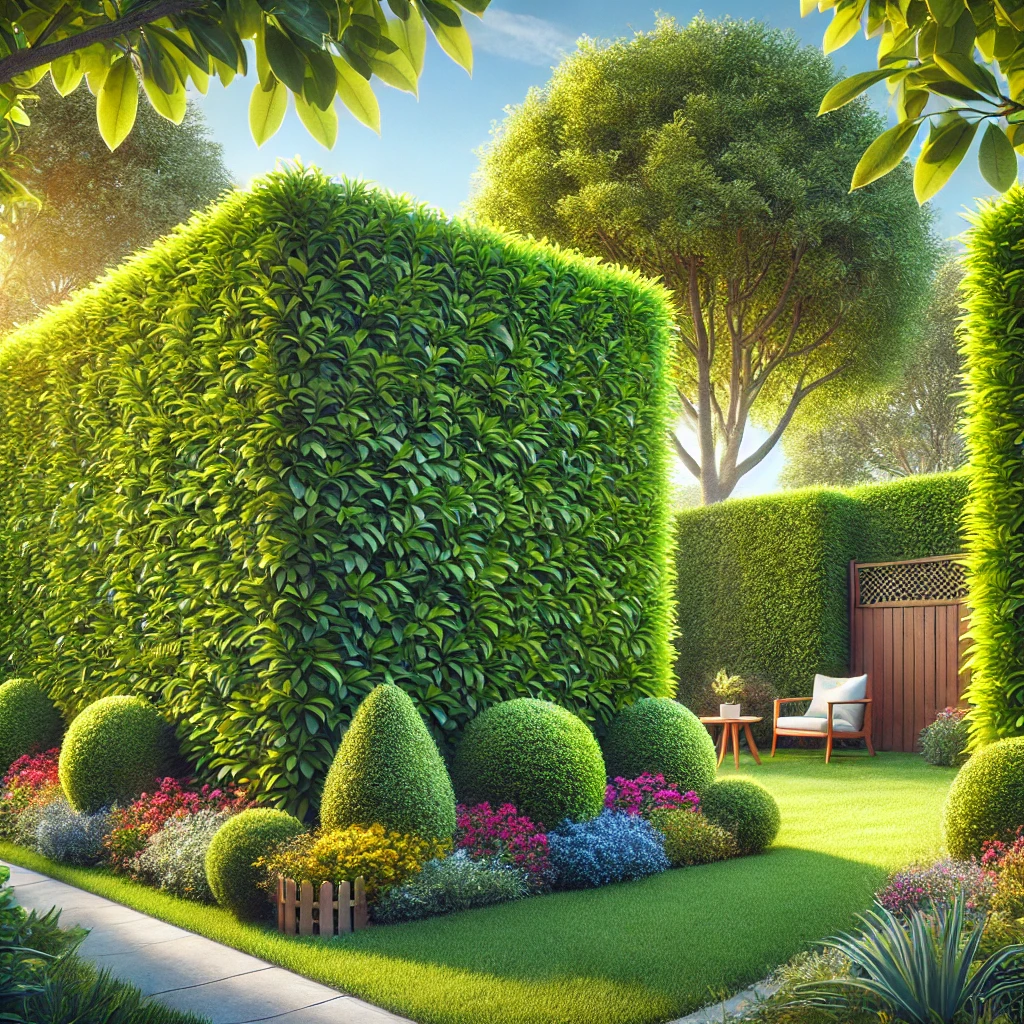
Whether you want a secluded backyard retreat or a screen along your property line, Ficus Tuffi is both functional and beautiful.
I first considered planting a privacy hedge after realizing how exposed my backyard felt. With neighboring houses nearby, I wanted to create a more intimate and tranquil space without building a fence or wall.
After researching my options, Ficus Tuffi stood out for its vibrant green leaves and low-maintenance nature. A friend had already planted it around her home, and seeing the lush, seamless hedge she’d grown convinced me it was the right choice.
The process of planting Ficus Tuffi was straightforward, but it required some planning. I chose a sunny spot with well-drained soil, as these are ideal conditions for the plant to thrive.
When spacing the saplings, I left about 50 centimeters between each one to ensure they had room to grow into a dense, continuous hedge. Within a year, the plants had filled out beautifully, creating a natural boundary that felt both private and inviting.
What makes Ficus Tuffi such an excellent choice for privacy barriers is its rapid growth. Within a few seasons, my hedge had reached over two meters in height, effectively blocking views into my garden.
Regular pruning kept it neat and encouraged bushier growth, making the hedge even more impenetrable. Trimming the hedge has become one of my favorite gardening tasks—it’s satisfying to see how quickly the plants respond and how polished they look afterward.
The aesthetic appeal of Ficus Tuffi is another reason it’s such a popular choice. Its glossy green leaves create a lush, vibrant backdrop that complements any garden design. I’ve planted flowering shrubs like hydrangeas and azaleas in front of my hedge, and the combination is stunning. The hedge provides structure and uniformity, while the flowers add pops of color, creating a balanced and visually pleasing space.
In addition to its beauty, Ficus Tuffi is incredibly practical. It’s a hardy plant that tolerates a wide range of conditions, from full sun to partial shade. I’ve found it to be particularly drought-tolerant, which is a bonus during the hot, dry summers in my region.
Occasional deep watering keeps the hedge healthy, but for the most part, it requires very little upkeep beyond pruning and occasional feeding.
Using Ficus Tuffi for privacy doesn’t just benefit you; it also supports local wildlife. Its dense foliage provides shelter for birds, and I often see sparrows and finches darting in and out of the hedge. One spring, a pair of blackbirds even built a nest among the branches, which was a delightful surprise.
Knowing that my hedge is more than just a barrier—it’s a home for wildlife—has added to my appreciation for this versatile plant.
Another thing I love about my Ficus Tuffi hedge is how it softens the edges of my property. Unlike a fence, which can feel rigid and imposing, the hedge has a natural flow that makes the space feel more welcoming. It also dampens noise from the street, creating a peaceful environment where I can relax without distraction.
On sunny afternoons, I often sit in my garden and marvel at how much the hedge has transformed the space.
Occasionally, I’ve had to deal with minor challenges, like ensuring the hedge gets enough sunlight in shaded areas. Adjusting the layout of surrounding plants and trimming back nearby trees resolved the issue, and the Ficus Tuffi quickly regained its vibrancy. Overall, these small adjustments have been well worth the benefits of having a lush, green privacy barrier around my home.
If you’re considering using Ficus Tuffi for privacy, I can’t recommend it enough. It’s a plant that combines beauty, practicality, and versatility, making it an ideal choice for any home. With a little care and patience, you can create a hedge that not only provides seclusion but also enhances the overall aesthetic of your outdoor space.
For me, planting Ficus Tuffi has been one of the most rewarding gardening decisions I’ve ever made, and I know it will continue to bring joy and tranquility for years to come.
Why Ficus Tuffi Is the Future of Modern Garden Design
Ficus Tuffi has quietly become one of the most versatile and reliable plants in modern garden design. With its sleek, glossy green foliage, fast growth, and adaptability, it offers a balance of beauty and functionality that is hard to match.
Whether you’re creating a minimalist landscape, a lush retreat, or a practical privacy screen, Ficus Tuffi fits seamlessly into nearly any vision. Its combination of low-maintenance care and visual appeal makes it a top contender for the future of outdoor design.

I first came across Ficus Tuffi when a friend recommended it for my backyard. I was struggling to find a hedge that could handle the windy conditions in my area while also complementing the clean lines of my contemporary home.
After planting a row of Ficus Tuffi, I was amazed at how quickly it grew into a dense, vibrant hedge that added both privacy and sophistication to my garden. It instantly became the backbone of my outdoor space, setting the tone for a modern, cohesive design.
What sets Ficus Tuffi apart is its ability to adapt to various roles in the garden. It’s most commonly used as a hedge, but its versatility extends far beyond that. In my neighborhood, I’ve seen Ficus Tuffi trained into elegant topiaries, creating focal points in minimalist courtyards.
I’ve also seen it used as a living wall in urban spaces, where its lush greenery adds a touch of nature to stark concrete surroundings. The plant’s ability to complement different styles, from sleek modern designs to lush, naturalistic landscapes, is one of the reasons it’s becoming so popular.
One of Ficus Tuffi’s greatest strengths is its resilience. It thrives in a wide range of climates and soil conditions, making it an excellent choice for gardeners in both coastal and inland areas. I’ve found that it’s surprisingly drought-tolerant once established, which is a huge bonus during the hot, dry summers in my region.
Its ability to handle challenging conditions with minimal care makes it ideal for modern gardens, where simplicity and sustainability often take priority.
Another reason Ficus Tuffi is gaining traction in contemporary landscaping is its ability to create a sense of enclosure and privacy without feeling heavy or overpowering. Unlike fences or walls, a Ficus Tuffi hedge softens the edges of a garden, creating a natural boundary that feels more inviting.
I’ve used it to frame my patio, and the effect is both functional and aesthetically pleasing. The hedge provides just enough separation from the neighboring property while maintaining an open, airy feel.
In addition to its practical benefits, Ficus Tuffi is a standout for its visual appeal. The plant’s dense, glossy leaves catch the light beautifully, adding a dynamic quality to the garden. I’ve paired my hedge with flowering plants like lavender and agapanthus, and the contrast between the vibrant green foliage and colorful blooms is stunning.
It’s a reminder that functionality doesn’t have to come at the expense of beauty, and with Ficus Tuffi, you can have both.
Ficus Tuffi also supports the growing trend toward eco-friendly gardening. Its dense foliage provides shelter for birds and small animals, making it a valuable addition to any garden ecosystem. I’ve noticed sparrows nesting in my hedge during the spring, and it’s been a joy to watch them come and go.
Beyond its wildlife benefits, the plant’s ability to tolerate drought and thrive with minimal inputs makes it a sustainable choice for gardeners looking to reduce their environmental footprint.
As modern gardens increasingly prioritize multifunctional plants, Ficus Tuffi’s versatility shines. In small urban gardens, it can be planted in containers to create portable privacy screens or living walls. In larger spaces, it can be used to define zones, add structure, or create a stunning backdrop for more colorful plants.
The possibilities are nearly endless, and its adaptability ensures it can meet the needs of both homeowners and professional landscapers.
The future of garden design is leaning toward simplicity, sustainability, and elegance, and Ficus Tuffi embodies all three. Its low-maintenance nature, coupled with its ability to thrive in diverse environments, makes it an obvious choice for anyone looking to create a stylish yet practical outdoor space.
For me, it’s become a central feature of my garden, and I can’t imagine designing a modern landscape without it.
If you’re looking for a plant that combines beauty, resilience, and versatility, Ficus Tuffi is worth considering. Its timeless appeal and ability to adapt to the changing demands of modern gardening make it a plant that’s not just relevant today but also poised to remain a favorite for years to come.
With Ficus Tuffi, the future of garden design is not just green—it’s lush, sustainable, and effortlessly beautiful.
Beyond the Hedge: Creative Uses for Ficus Tuffi in Landscaping
Ficus Tuffi is a plant that’s often celebrated for its use as a hedge, but its potential goes far beyond creating boundaries. With its lush, glossy green foliage, fast growth, and versatility, Ficus Tuffi can play a variety of roles in modern landscaping.

Whether you’re looking to add structure, create a focal point, or incorporate natural beauty into your outdoor space, this plant offers endless possibilities. Thinking beyond the hedge opens up a world of creative opportunities to transform your garden into something truly special.
I first planted Ficus Tuffi with the straightforward goal of creating a privacy screen. Its rapid growth and dense foliage made it the perfect solution for shielding my backyard from prying eyes. But as I worked with it, I started to see how flexible this plant really is.
Over the years, I’ve experimented with using Ficus Tuffi in different ways, and each time, it has exceeded my expectations.
One of the most stunning uses I’ve seen for Ficus Tuffi is as a living wall. In a friend’s urban courtyard, Ficus Tuffi has been trained to climb a vertical trellis, creating a vibrant green backdrop that softens the surrounding brick and concrete.
The dense foliage provides insulation and privacy while adding a touch of nature to an otherwise industrial setting. Inspired by this idea, I tried something similar in my garden, and the result was a lush, living piece of art that became the centerpiece of the space.
Ficus Tuffi also shines as a standalone feature plant. I’ve shaped one into a small tree in the corner of my garden, and it adds a touch of elegance to the design. Surrounded by flowering plants, the vibrant green of the Ficus Tuffi creates a striking contrast that draws the eye.
This approach works especially well in formal gardens, where symmetry and structure are key, but it can also bring a sense of balance to more relaxed, naturalistic landscapes.
Another creative use for Ficus Tuffi is as a border plant. Its compact growth habit and ability to be trimmed into neat shapes make it an ideal choice for edging pathways or defining garden beds.
I’ve used it to line a gravel path in my backyard, and the clean lines it creates are both functional and aesthetically pleasing. The hedge not only guides the flow of the garden but also provides a visual anchor that ties the design together.
For those with limited space, Ficus Tuffi can be grown in containers to create portable greenery. I’ve seen it used on patios and balconies, where its dense foliage offers privacy and a sense of seclusion.
A neighbor of mine has several potted Ficus Tuffi plants arranged along her deck, and they’ve transformed the space into a cozy, leafy retreat. The ability to move the plants around adds flexibility, allowing the layout to change with the seasons or the occasion.
One of the things I appreciate most about Ficus Tuffi is its ability to adapt to both formal and informal designs. In formal gardens, it can be shaped into geometric forms or even topiaries, adding structure and sophistication.
I once visited a botanical garden where Ficus Tuffi was trimmed into spirals and cones, creating a playful yet refined atmosphere. In contrast, letting it grow more naturally in a mixed border brings a sense of softness and flow that complements colorful perennials and ornamental grasses.
Ficus Tuffi also has practical benefits that make it a standout choice for creative landscaping. Its dense foliage acts as a sound barrier, reducing noise from nearby roads or neighbors. I’ve noticed a significant drop in noise levels since planting a row of Ficus Tuffi along my fence line.
Additionally, its ability to filter dust and improve air quality makes it a valuable addition to urban gardens, where green space is often limited.
The environmental benefits of Ficus Tuffi shouldn’t be overlooked. Its dense branches provide shelter for birds, and I’ve often seen sparrows and finches nesting in mine. Knowing that my garden supports local wildlife adds an extra layer of satisfaction to working with this plant. It’s a reminder that creative landscaping can benefit not just humans but the ecosystem as well.
Thinking beyond the hedge with Ficus Tuffi opens up so many possibilities for enhancing your outdoor space. Whether you’re creating a living wall, shaping it into a focal point, or using it to define borders, this plant offers a unique blend of beauty and functionality. For me, it has been a joy to experiment with different uses and see how it transforms my garden in new and exciting ways.
If you’re looking for a versatile, resilient, and visually stunning plant, Ficus Tuffi is hard to beat. It’s more than just a hedge—it’s a tool for creativity, a source of inspiration, and a cornerstone of modern landscaping. By thinking outside the box, you can unlock the full potential of Ficus Tuffi and create a garden that’s not only beautiful but also uniquely yours.
Troubleshooting Common Problems with Ficus Tuffi Hedges
Ficus Tuffi hedges are a favorite among gardeners for their lush greenery, rapid growth, and low-maintenance nature. However, even the hardiest plants can encounter challenges from time to time.
Whether it’s leaf discoloration, pests, or uneven growth, troubleshooting common problems with Ficus Tuffi doesn’t have to be complicated. With a bit of knowledge and a hands-on approach, you can keep your hedge thriving and beautiful year-round.

I first planted Ficus Tuffi as a privacy screen along the edge of my garden. It was a game-changer, growing quickly into a dense hedge that provided the seclusion I wanted. But within a year, I started noticing some yellowing leaves and sparse patches.
At first, I was worried I had made a mistake choosing this plant, but after some research and trial and error, I realized that most problems are easily solved with the right care.
One of the most common issues with Ficus Tuffi is yellowing leaves, which often indicate overwatering or poor drainage. I made this mistake early on, thinking more water meant faster growth. The result was soggy soil that stressed the roots.
Once I adjusted my watering schedule—allowing the soil to dry out between deep waterings—the hedge began to recover. Improving drainage by mixing compost into the soil also helped prevent waterlogging and kept the roots healthy.
Another challenge I faced was uneven growth, with some sections of the hedge filling out beautifully while others lagged behind. This can often be traced back to inconsistent sunlight. Ficus Tuffi thrives in full sun but can tolerate partial shade. In my case, a nearby tree was casting shadows over part of the hedge, limiting its growth.
Trimming back the tree branches allowed more light to reach the affected area, and within a few weeks, the hedge started evening out.
Pests like scale insects and aphids can occasionally be an issue with Ficus Tuffi. I noticed sticky residue on some of the leaves one summer, a clear sign of aphid activity. Instead of reaching for chemical sprays, I opted for a natural solution.
Spraying the affected areas with a mixture of water, a few drops of dish soap, and neem oil quickly resolved the problem. Introducing ladybugs to the garden also helped control the aphid population naturally.
Leaf drop is another issue that can occur, particularly during periods of stress. I experienced this after an unusually cold winter, when some of the leaves on my hedge began falling off. While it was alarming at first, I learned that Ficus Tuffi is resilient and usually bounces back once conditions improve.
Pruning the damaged branches and giving the hedge a boost with an organic fertilizer in spring helped it recover fully.
Fungal issues, such as leaf spot, can arise during prolonged periods of humidity. I noticed small black spots on a few leaves during a particularly rainy season. To address this, I thinned out the interior branches during pruning to improve airflow and reduce moisture buildup. Removing the affected leaves and applying a natural fungicide made from diluted neem oil kept the problem from spreading.
Regular pruning is essential for preventing many common issues and maintaining a healthy Ficus Tuffi hedge. I’ve found that trimming the hedge twice a year—in spring and late summer—encourages bushier growth and keeps it looking neat. Sharp, clean tools are a must to avoid damaging the branches, and I always step back periodically during pruning to ensure the hedge maintains a uniform shape.
Feeding your hedge is another simple but effective way to prevent problems. I use a slow-release fertilizer in early spring, which provides the nutrients Ficus Tuffi needs for vigorous growth. Adding a layer of organic mulch around the base helps retain moisture and enrich the soil, creating the ideal environment for healthy roots. These small steps make a big difference in keeping the hedge strong and resilient.
What I’ve come to appreciate about Ficus Tuffi is its ability to recover from challenges. Whether it’s pest infestations, environmental stress, or pruning mishaps, this plant seems to bounce back with a bit of care and attention.
Watching my hedge thrive after overcoming these obstacles has been one of the most rewarding aspects of gardening. It’s a reminder that even the best plants need a little help sometimes, and troubleshooting is part of the journey.
If you’re facing issues with your Ficus Tuffi hedge, don’t be discouraged. Most problems have straightforward solutions, and with a little patience, your hedge can return to its full glory. From adjusting your watering routine to addressing pests and improving sunlight exposure, the key is to stay observant and proactive.
With the right approach, you’ll enjoy a lush, vibrant Ficus Tuffi hedge that enhances your garden for years to come.
The Architectural Elegance of Ficus Tuffi: Modern Sculptural Gardens Redefined
In the world of modern garden design, Ficus Tuffi has emerged as a plant that goes far beyond traditional hedging. Its dense, glossy foliage, fast growth, and malleable structure make it the perfect canvas for sculptural landscaping.

Whether used to create geometric shapes, contemporary living walls, or flowing organic forms, Ficus Tuffi is redefining what’s possible in modern gardens. Its ability to merge functionality with art is transforming outdoor spaces into stunning works of living architecture.
When I first encountered Ficus Tuffi, it was part of a striking garden at a contemporary home I visited. Instead of a simple hedge, the plants had been shaped into sleek, vertical columns that framed the pathway.
The effect was breathtaking, combining structure and greenery in a way that felt both elegant and approachable. Inspired, I decided to experiment with Ficus Tuffi in my own garden, and it’s been a creative journey ever since.
What makes Ficus Tuffi such an exciting choice for modern sculptural gardens is its adaptability. The plant’s dense foliage can be pruned and trained into almost any shape, from sharp-edged cubes and spheres to flowing organic forms.
I started small, trimming mine into low box shapes to define the edges of my patio, and gradually moved on to more ambitious designs. Today, I have a series of tall Ficus Tuffi columns that serve as a natural screen between my garden and a neighboring property.
One of the most innovative uses I’ve seen for Ficus Tuffi is as a living wall. In urban spaces where greenery is often limited, these vertical installations bring a touch of nature to patios, courtyards, and even interiors.
A local café near me recently installed a Ficus Tuffi living wall, and the result is both practical and visually stunning. The wall acts as a noise buffer, air purifier, and design feature all in one, creating a lush, welcoming environment for patrons.
Creating sculptural elements with Ficus Tuffi requires a bit of patience and planning, but the results are worth the effort. When shaping mine, I’ve found it helpful to use wooden frames or wire guides to train the plants as they grow.
Regular trimming ensures the design stays crisp, and the plants respond well to this care, producing fresh growth that enhances the overall look. The process feels as much like art as it does gardening, and each step brings a sense of satisfaction.
In addition to its sculptural potential, Ficus Tuffi offers practical benefits that make it a favorite for modern designs. Its rapid growth and resilience mean it quickly fills out any shape you choose, and its glossy green leaves create a polished, contemporary look.
I’ve paired mine with hardscape elements like concrete and steel, and the contrast between the soft foliage and industrial materials is striking. This ability to bridge the gap between natural and man-made elements makes Ficus Tuffi ideal for today’s minimalist landscapes.
Beyond its aesthetic appeal, Ficus Tuffi also supports eco-friendly design principles. Its dense foliage helps improve air quality, and its ability to act as a natural sound barrier is invaluable in urban settings. In my own garden, the tall Ficus Tuffi columns I’ve grown along my fence line have noticeably reduced noise from the street, creating a more peaceful outdoor space.
Knowing that my creative designs are not just beautiful but also functional adds to my appreciation for this versatile plant.
The possibilities for Ficus Tuffi in sculptural gardens are nearly endless, from small, detailed designs to large, bold statements. I’ve seen it used to create spiral topiaries, winding hedge pathways, and even abstract forms that resemble modern art sculptures.
Each design showcases the plant’s ability to adapt to different styles and settings, making it a go-to choice for both professional landscapers and home gardeners.
What I love most about working with Ficus Tuffi is how it encourages creativity. Whether you’re shaping it into a simple hedge or an intricate design, the process feels rewarding and personal.
My garden has become a reflection of my own style and imagination, and Ficus Tuffi has played a huge role in making that possible. Its architectural elegance and versatility have transformed my outdoor space into something I never thought I could achieve.
If you’re looking to redefine your garden with modern sculptural elements, Ficus Tuffi is the perfect starting point. Its ability to combine beauty, functionality, and creativity makes it a standout choice for any design.
Whether you’re shaping a sleek column, crafting a living wall, or experimenting with abstract forms, this remarkable plant offers endless possibilities. With Ficus Tuffi, your garden can become a masterpiece of living art.
The Secret to a Low-Maintenance Ficus Tuffi Hedge
Ficus Tuffi is one of those plants that feels like it was made for modern gardening. With its glossy green leaves, fast growth, and ability to thrive with minimal care, it’s no wonder so many gardeners are drawn to it.

Whether you’re looking to create a sleek privacy hedge or add structure to your outdoor space, Ficus Tuffi offers a versatile and low-maintenance solution. The best part? You don’t need a green thumb or hours of effort to keep it looking its best.
When I first planted a Ficus Tuffi hedge, I was a little skeptical about its reputation for being easy to care for. I’d had my fair share of struggles with other hedges, from slow growth to constant pruning demands.
But I was pleasantly surprised by how quickly my Ficus Tuffi plants settled in and began to thrive. Within months, I had a lush, green wall that required only occasional attention to keep it looking polished.
The first secret to a low-maintenance Ficus Tuffi hedge is giving it the right start. This plant is incredibly adaptable, but like all hedges, it benefits from good soil preparation. Before planting, I loosened the soil and mixed in compost to create a nutrient-rich environment for the roots.
Spacing the plants about 50 centimeters apart ensured that they had room to grow without overcrowding. This initial effort paid off, as the hedge filled out evenly without requiring frequent adjustments.
Once established, Ficus Tuffi’s ability to thrive with minimal watering is a game-changer. During the first year, I watered the hedge deeply once a week to help the roots establish. After that, it became remarkably drought-tolerant, needing only occasional watering during extended dry spells.
I’ve found that a layer of mulch around the base of the plants helps retain moisture and reduces the need for frequent watering. This simple step has made a big difference in keeping my hedge healthy without much effort.
Pruning is another area where Ficus Tuffi shines as a low-maintenance choice. Unlike some hedges that require constant trimming to maintain their shape, Ficus Tuffi has a naturally tidy growth habit. I usually give my hedge a light trim twice a year—once in spring and again in late summer.
This keeps it looking neat while encouraging denser growth. One year, I skipped a trimming session, and to my surprise, the hedge still looked great, just a little more informal. That’s the beauty of Ficus Tuffi, it’s forgiving and doesn’t demand perfection.
Feeding your Ficus Tuffi hedge is straightforward and doesn’t require constant attention. I use a balanced slow-release fertilizer in early spring to provide the nutrients it needs for healthy growth.
Occasionally, I’ll supplement with a liquid seaweed feed if the foliage starts to look a bit dull. These small efforts go a long way in maintaining the hedge’s vibrant green color and resilience.
One of the challenges I’ve encountered with other plants is pest control, but Ficus Tuffi has proven to be surprisingly resistant. In the few instances where I’ve noticed pests, such as scale insects, a simple spray of soapy water has been enough to resolve the issue. Keeping the hedge well-fed and watered also helps it resist pests naturally, reducing the need for chemical treatments.
Ficus Tuffi’s low-maintenance nature extends to its resilience against environmental challenges. I live in an area with strong winds, and this hedge has stood up beautifully without showing signs of stress.
Its deep root system anchors it firmly in place, while its dense foliage provides effective wind protection for other plants in my garden. For gardeners in urban settings, Ficus Tuffi is also a great choice for filtering out dust and pollution, making it a functional as well as an aesthetic addition.
One of my favorite things about Ficus Tuffi is how versatile it is in different garden designs. In my own garden, I’ve used it as a tall privacy screen, but a friend of mine has planted it as a low border hedge along her driveway.
Another gardener I know has shaped his Ficus Tuffi hedge into elegant topiaries, which add a touch of whimsy to his otherwise minimalist space. Regardless of how it’s used, the hedge maintains its beauty with minimal effort, allowing you to enjoy your garden without feeling tied to it.
The real secret to a low-maintenance Ficus Tuffi hedge lies in finding a balance between care and letting the plant do what it does best. By giving it the right conditions at the start and providing occasional maintenance, you can achieve a hedge that looks professional without the time commitment. For me, this has meant more time to enjoy my garden and less time worrying about upkeep.
As I sit on my patio, looking out at the sleek, vibrant hedge that defines my outdoor space, I’m reminded of why I chose Ficus Tuffi in the first place. Its combination of beauty, resilience, and ease has made it one of the best decisions I’ve made as a gardener.
If you’re looking for a hedge that offers style without the stress, Ficus Tuffi is the perfect choice. With just a little care, it will reward you with lush, green growth that elevates your garden year after year.
Ficus Tuffi for Privacy: Building a Natural, Elegant Screen
Creating privacy in your outdoor space doesn’t have to mean sacrificing style. With Ficus Tuffi, you can have both. This evergreen beauty is fast becoming a favorite for gardeners and homeowners looking for an elegant yet practical solution to create a natural screen.

Its dense foliage, easy growth habit, and year-round greenery make it the ideal choice for building a private retreat, no matter the size or style of your space.
When I first decided to plant a Ficus Tuffi hedge, I was desperate for a solution to block the view of my neighbor’s driveway. My yard felt exposed, and I wanted something that would grow quickly but also enhance the aesthetics of my garden. Ficus Tuffi came highly recommended, and it didn’t take long for me to see why.
Within months, the hedge had begun to fill out, creating a lush green barrier that gave me the privacy I had been longing for.
One of the standout features of Ficus Tuffi is its ability to grow quickly and evenly, making it perfect for creating a seamless screen. Unlike some plants that can take years to mature, Ficus Tuffi establishes itself quickly, providing coverage in a relatively short amount of time.
In my own garden, I spaced the plants about 60 centimeters apart, ensuring that they would grow into a dense, continuous hedge. To give them the best start, I enriched the soil with compost and watered them deeply once a week during the first year. This early care paid off, and by the second year, my hedge was tall, vibrant, and lush.
What I love most about Ficus Tuffi is how it combines functionality with elegance. Its glossy green leaves and tidy growth habit create a polished look that complements both modern and traditional garden styles.
A friend of mine planted a Ficus Tuffi hedge along the edge of her sleek, minimalist patio, and it looks like something out of a magazine. The hedge not only provides privacy but also acts as a backdrop for her outdoor furniture, creating a cohesive and inviting space.
For those looking to build a natural screen, the height of a Ficus Tuffi hedge is another major advantage. With regular trimming, it can be maintained at a height that suits your needs, whether you’re looking to block out ground-level views or create a taller barrier for second-story windows.
In my case, I’ve kept my hedge at about two meters, which is just enough to create a sense of enclosure without feeling overwhelming. Trimming twice a year, in spring and late summer, has been enough to keep it looking neat and tidy.
Another reason Ficus Tuffi is such a popular choice for privacy is its year-round appeal. As an evergreen, it provides consistent coverage and color no matter the season. This was especially important to me, as I wanted a solution that wouldn’t leave my garden feeling bare in the winter months. Even during the colder seasons, my Ficus Tuffi hedge remains vibrant and full, adding a touch of life to the garden when most other plants are dormant.
The low-maintenance nature of Ficus Tuffi makes it even more appealing. Once established, it requires minimal watering, thriving on occasional deep watering during dry spells. I’ve also found that applying a slow-release fertilizer in spring helps keep the foliage looking its best.
For pest control, Ficus Tuffi is relatively resistant, but I’ve had a few instances of scale insects, which I easily managed with a spray of soapy water. Overall, the hedge has been a joy to care for, requiring far less effort than I initially expected.
Ficus Tuffi also offers a level of flexibility that other privacy solutions can’t match. While my hedge follows a straight line along my property boundary, I’ve seen others use Ficus Tuffi to create curved or even freeform screens.
A neighbor of mine has shaped hers into an archway leading into a garden seating area, and the result is both functional and artistic. Another friend has planted her Ficus Tuffi hedge in large pots, allowing her to move the screen around her patio as needed. This versatility makes it a fantastic choice for all kinds of spaces, from sprawling gardens to compact urban courtyards.
Incorporating Ficus Tuffi into your garden also supports sustainability. Its dense foliage not only provides privacy but also serves as a habitat for birds and beneficial insects. I often see small birds darting in and out of my hedge, and their presence adds a sense of life and vibrancy to the space. It’s a reminder that privacy doesn’t have to come at the expense of nature; in fact, it can enhance it.
The beauty of Ficus Tuffi is that it doesn’t just create a physical barrier—it transforms your outdoor space into a sanctuary. I can’t count the number of times I’ve sat in my garden, enjoying the tranquility created by my hedge. It’s more than just a screen; it’s a feature that adds depth, texture, and a sense of serenity to my home.
If you’re looking for a way to combine privacy with style, Ficus Tuffi is a solution that truly delivers. Its rapid growth, year-round greenery, and low-maintenance nature make it a standout choice for anyone looking to enhance their garden.
Whether you’re creating a cozy courtyard or defining the edges of a larger property, Ficus Tuffi offers a natural, elegant screen that will make your outdoor space feel private, polished, and effortlessly beautiful.
Why Ficus Tuffi is the Low-Maintenance Hedge You’ve Been Looking For
If you’ve been dreaming of a lush, green hedge that adds beauty and structure to your garden without taking up all your time, Ficus Tuffi might be exactly what you’re looking for. This hardy evergreen hedge has quickly become a favorite for gardeners seeking a balance between elegance and ease.
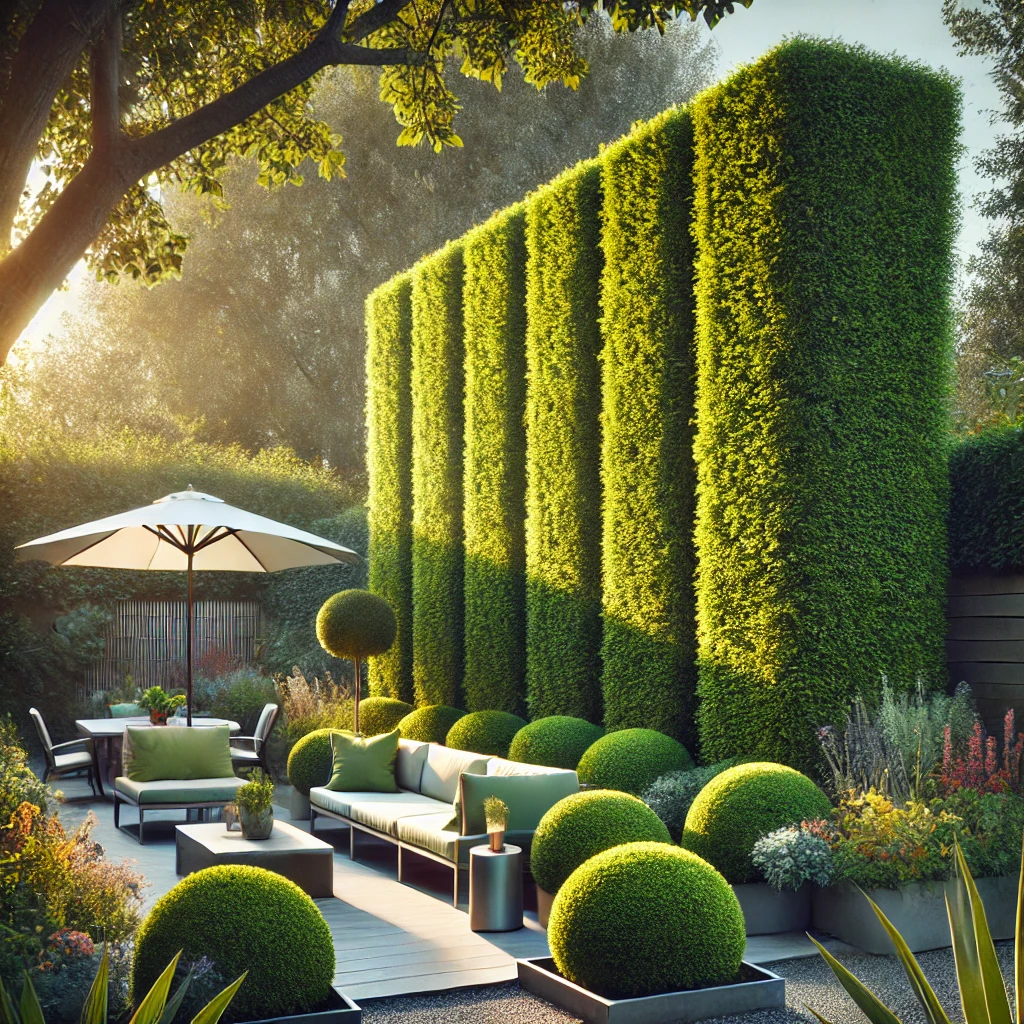
With its vibrant foliage, rapid growth, and minimal care requirements, Ficus Tuffi proves that low-maintenance gardening doesn’t mean compromising on style.
When I first planted Ficus Tuffi along my garden’s boundary, I was hesitant. Could a hedge really thrive without constant attention? My previous hedging plants required frequent pruning, watering, and pest control. But within months of planting Ficus Tuffi, I realized I’d found a game changer.
The hedge began to grow in dense and healthy, creating a natural privacy screen with very little input on my part.
One of the standout features of Ficus Tuffi is its adaptability. Whether you’re working with a large outdoor space or a compact urban garden, this hedge fits seamlessly into a variety of landscapes. I’ve seen it used to define sprawling lawns in rural areas and as a tidy green wall for small courtyards in the city. Its versatility means you can shape it to fit your specific needs, whether that’s a tall privacy hedge or a low border for pathways and garden beds.
Watering is often a major concern for gardeners, especially in regions where water conservation is important. Ficus Tuffi simplifies this challenge by being remarkably drought-tolerant once established. In the first year after planting, I made sure to water deeply once a week to encourage strong root development.
After that, the hedge needed minimal irrigation, even during dry spells. Mulching around the base of the plants helped retain moisture and reduced the need for frequent watering, making it an eco-friendly choice for my garden.
Pruning, a task that many gardeners dread, is refreshingly simple with Ficus Tuffi. The hedge has a naturally tidy growth habit, which means it doesn’t require constant trimming to look neat. I typically prune mine twice a year, in spring and late summer, to maintain its shape and encourage fuller growth.
One year, I skipped the summer pruning entirely, and to my surprise, the hedge still looked great. This forgiving nature makes it ideal for gardeners who don’t have time for frequent maintenance but still want a polished outdoor space.
Feeding Ficus Tuffi is equally straightforward. A slow-release fertilizer applied in early spring provides all the nutrients it needs for the year. Occasionally, I’ll add a liquid seaweed solution if the foliage starts to look dull, but that’s more of a bonus than a necessity. Its resilience and low demand for additional care mean that you can enjoy a thriving hedge without having to fuss over it constantly.
Pest control is another area where Ficus Tuffi shines. Unlike some hedging plants that are prone to infestations, this hardy species is relatively pest-resistant. I’ve only encountered minor issues with scale insects, which I managed easily with a spray of soapy water.
Keeping the hedge healthy through proper watering and feeding has also helped ward off pests, so I’ve rarely had to think about it.
Beyond its practicality, Ficus Tuffi brings undeniable beauty to any garden. Its glossy, vibrant green leaves create a striking backdrop for other plants and flowers. I’ve paired my hedge with colorful perennials, and the result is a garden that feels both cohesive and dynamic.
A friend of mine has used Ficus Tuffi as a tall privacy screen around her pool area, and the lush greenery gives the space a resort-like feel. Another neighbor shaped her hedge into a series of soft curves, adding a touch of whimsy to her modern garden.
One of the most rewarding aspects of having a Ficus Tuffi hedge is how it transforms the atmosphere of your outdoor space. In my own garden, the hedge creates a sense of enclosure and tranquility, making it feel like a private retreat.
It also acts as a windbreak, protecting more delicate plants and creating a microclimate that supports a variety of greenery. For urban gardeners, the hedge serves as a natural sound barrier, reducing noise from busy streets and creating a more peaceful environment.
For those who love creative gardening, Ficus Tuffi offers endless possibilities. While I’ve kept my hedge relatively straightforward, I’ve seen it shaped into intricate topiaries, used as a backdrop for outdoor art installations, and even incorporated into vertical garden designs. Its flexibility and forgiving nature make it a favorite among both beginner and experienced gardeners.
If you’re looking for a hedge that combines beauty, practicality, and ease of care, Ficus Tuffi is hard to beat. Its low-maintenance nature allows you to focus on enjoying your garden rather than constantly working in it. Whether you’re creating a cozy courtyard, framing a walkway, or building a private oasis, this versatile hedge will deliver stunning results with minimal effort.
For me, planting Ficus Tuffi was one of the best gardening decisions I’ve ever made. It’s not just a hedge; it’s a feature that has enhanced the look and feel of my entire garden. If you’re ready to simplify your gardening routine without sacrificing style, Ficus Tuffi might just be the perfect plant for you.
